Communication and Negotiation Skills: Case Study Analysis and Questions
VerifiedAdded on 2023/06/10
|25
|9086
|383
AI Summary
This case study analysis and questions on communication and negotiation skills for Desklib provides solutions to tackle the challenges faced by Barry, the kitchen manager, due to ineffective communication. It also suggests standard operating procedures and ways to use effective communication as a motivator for employees to follow safe food handling practices.
Contribute Materials
Your contribution can guide someone’s learning journey. Share your
documents today.
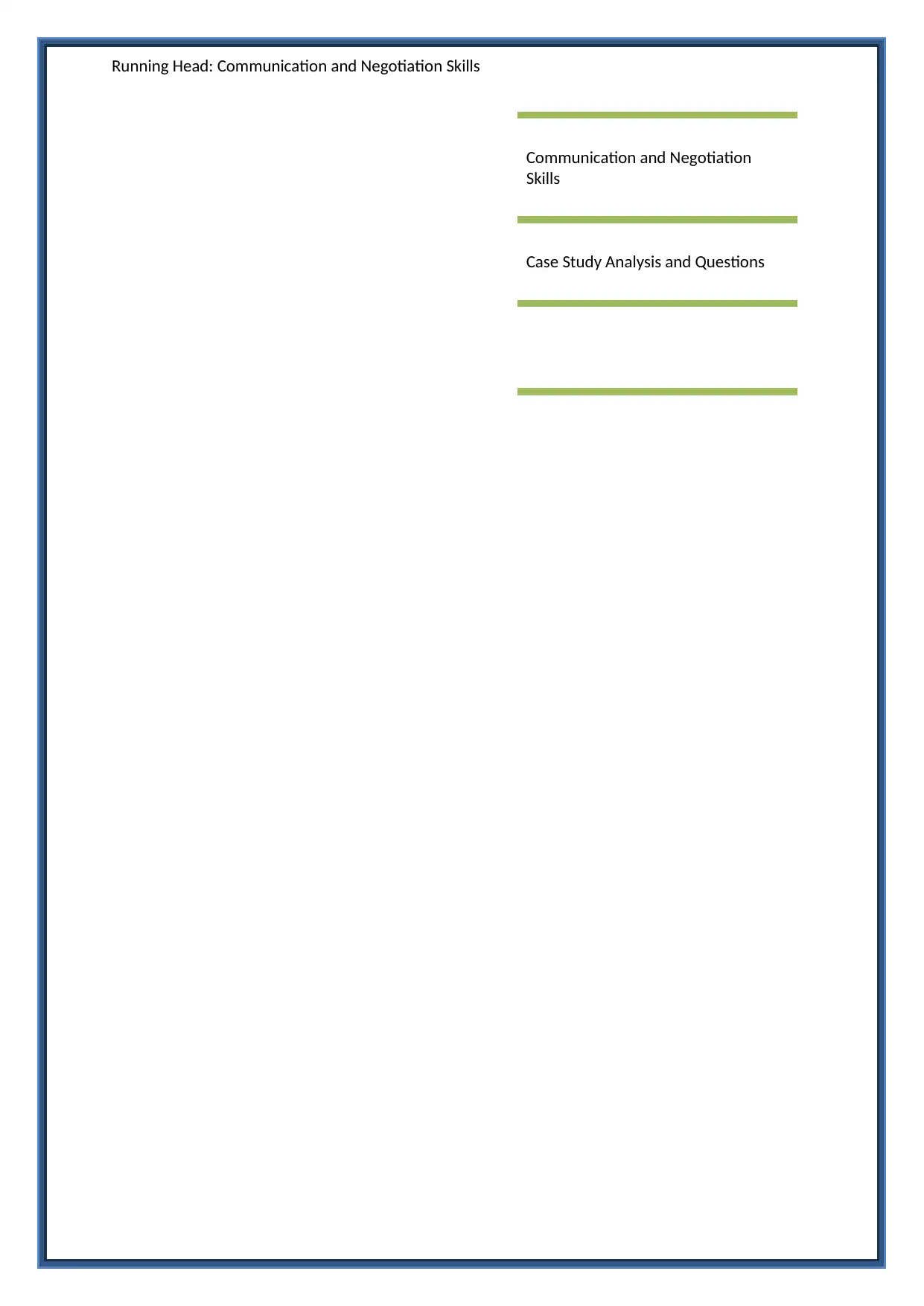
Running Head: Communication and Negotiation Skills
Communication and Negotiation
Skills
Case Study Analysis and Questions
Communication and Negotiation
Skills
Case Study Analysis and Questions
Secure Best Marks with AI Grader
Need help grading? Try our AI Grader for instant feedback on your assignments.
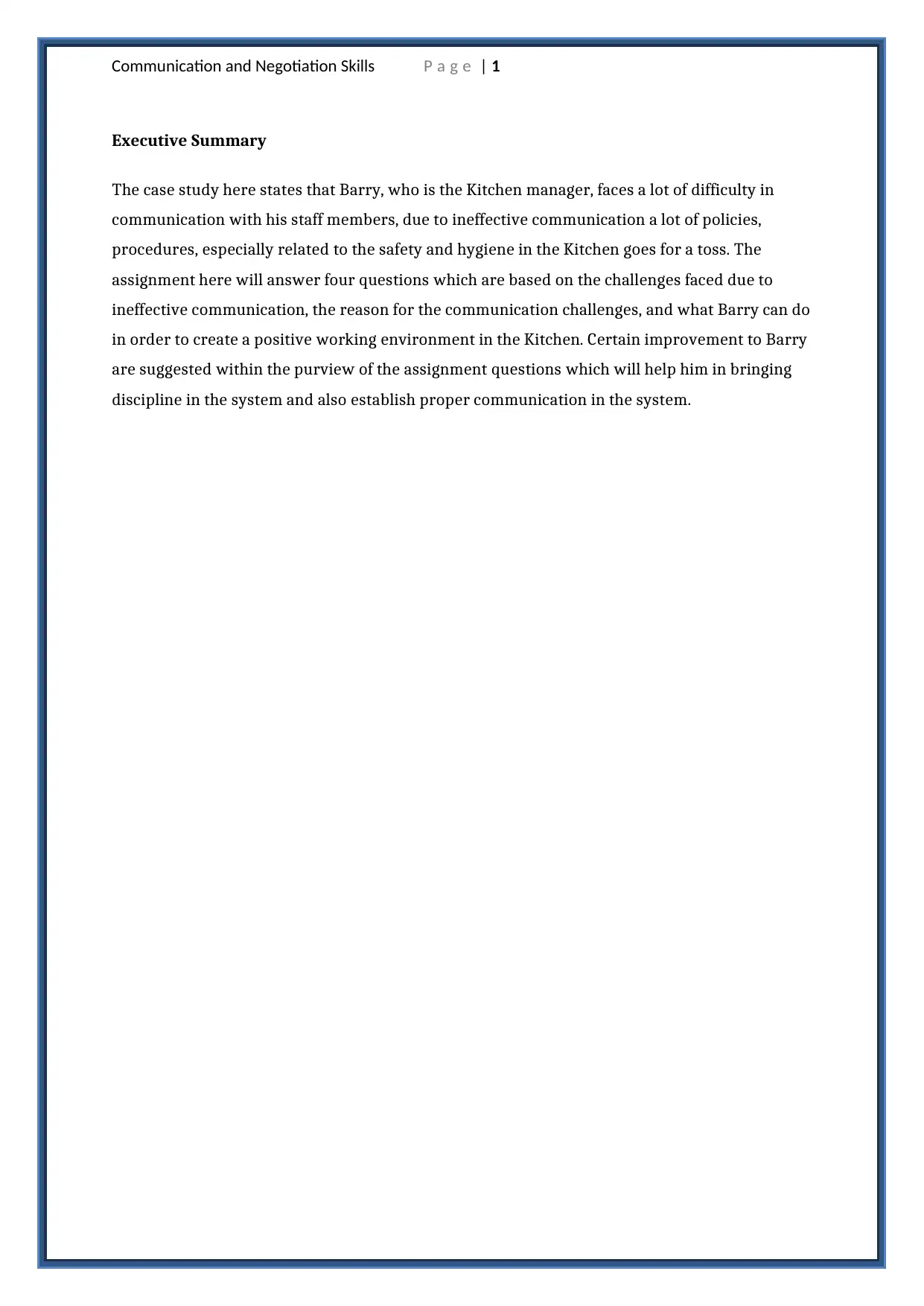
Communication and Negotiation Skills P a g e | 1
Executive Summary
The case study here states that Barry, who is the Kitchen manager, faces a lot of difficulty in
communication with his staff members, due to ineffective communication a lot of policies,
procedures, especially related to the safety and hygiene in the Kitchen goes for a toss. The
assignment here will answer four questions which are based on the challenges faced due to
ineffective communication, the reason for the communication challenges, and what Barry can do
in order to create a positive working environment in the Kitchen. Certain improvement to Barry
are suggested within the purview of the assignment questions which will help him in bringing
discipline in the system and also establish proper communication in the system.
Executive Summary
The case study here states that Barry, who is the Kitchen manager, faces a lot of difficulty in
communication with his staff members, due to ineffective communication a lot of policies,
procedures, especially related to the safety and hygiene in the Kitchen goes for a toss. The
assignment here will answer four questions which are based on the challenges faced due to
ineffective communication, the reason for the communication challenges, and what Barry can do
in order to create a positive working environment in the Kitchen. Certain improvement to Barry
are suggested within the purview of the assignment questions which will help him in bringing
discipline in the system and also establish proper communication in the system.
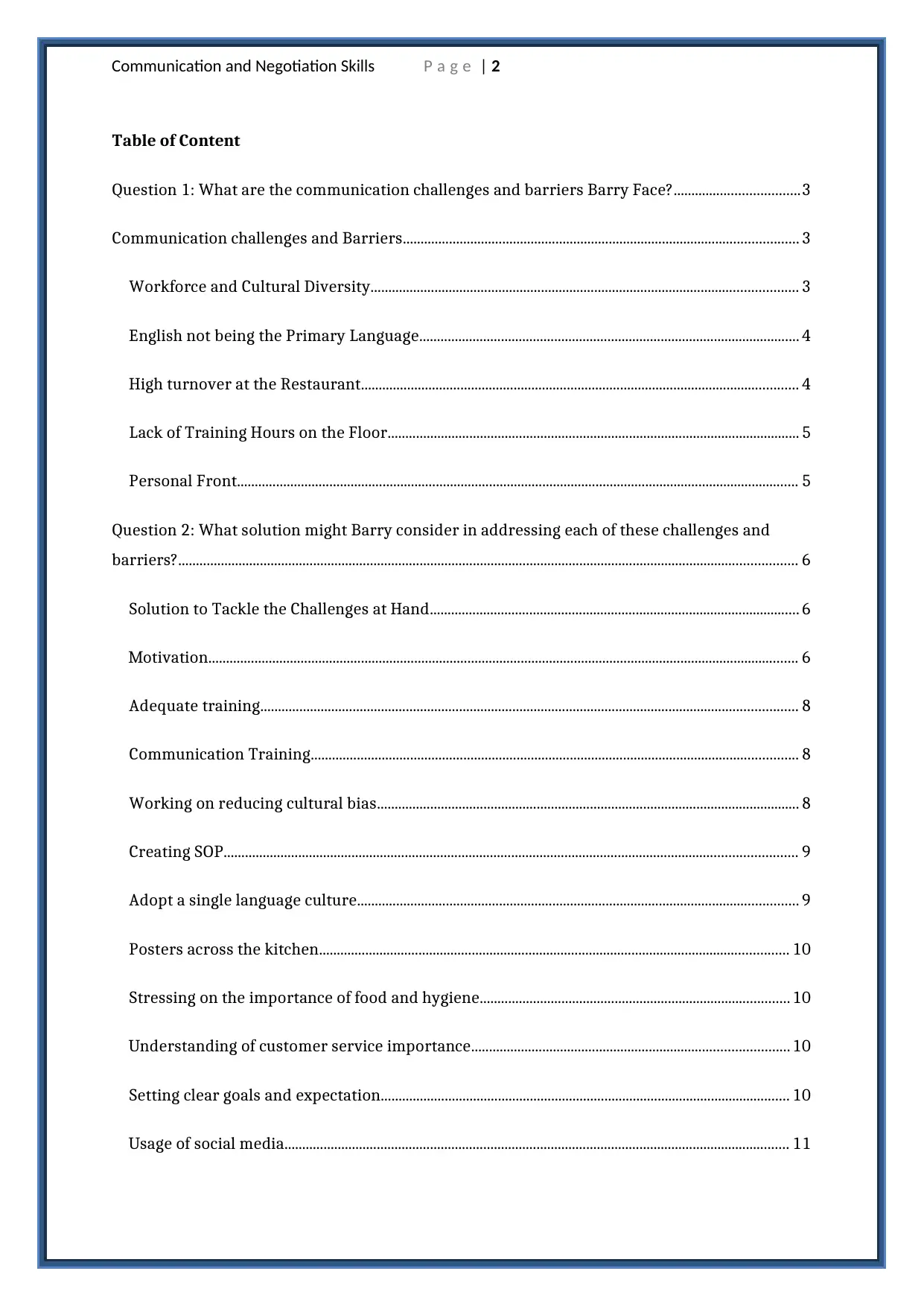
Communication and Negotiation Skills P a g e | 2
Table of Content
Question 1: What are the communication challenges and barriers Barry Face?...................................3
Communication challenges and Barriers............................................................................................................... 3
Workforce and Cultural Diversity........................................................................................................................ 3
English not being the Primary Language........................................................................................................... 4
High turnover at the Restaurant........................................................................................................................... 4
Lack of Training Hours on the Floor.................................................................................................................... 5
Personal Front.............................................................................................................................................................. 5
Question 2: What solution might Barry consider in addressing each of these challenges and
barriers?.............................................................................................................................................................................. 6
Solution to Tackle the Challenges at Hand........................................................................................................ 6
Motivation...................................................................................................................................................................... 6
Adequate training....................................................................................................................................................... 8
Communication Training......................................................................................................................................... 8
Working on reducing cultural bias....................................................................................................................... 8
Creating SOP................................................................................................................................................................. 9
Adopt a single language culture............................................................................................................................ 9
Posters across the kitchen.................................................................................................................................... 10
Stressing on the importance of food and hygiene....................................................................................... 10
Understanding of customer service importance......................................................................................... 10
Setting clear goals and expectation................................................................................................................... 10
Usage of social media.............................................................................................................................................. 11
Table of Content
Question 1: What are the communication challenges and barriers Barry Face?...................................3
Communication challenges and Barriers............................................................................................................... 3
Workforce and Cultural Diversity........................................................................................................................ 3
English not being the Primary Language........................................................................................................... 4
High turnover at the Restaurant........................................................................................................................... 4
Lack of Training Hours on the Floor.................................................................................................................... 5
Personal Front.............................................................................................................................................................. 5
Question 2: What solution might Barry consider in addressing each of these challenges and
barriers?.............................................................................................................................................................................. 6
Solution to Tackle the Challenges at Hand........................................................................................................ 6
Motivation...................................................................................................................................................................... 6
Adequate training....................................................................................................................................................... 8
Communication Training......................................................................................................................................... 8
Working on reducing cultural bias....................................................................................................................... 8
Creating SOP................................................................................................................................................................. 9
Adopt a single language culture............................................................................................................................ 9
Posters across the kitchen.................................................................................................................................... 10
Stressing on the importance of food and hygiene....................................................................................... 10
Understanding of customer service importance......................................................................................... 10
Setting clear goals and expectation................................................................................................................... 10
Usage of social media.............................................................................................................................................. 11
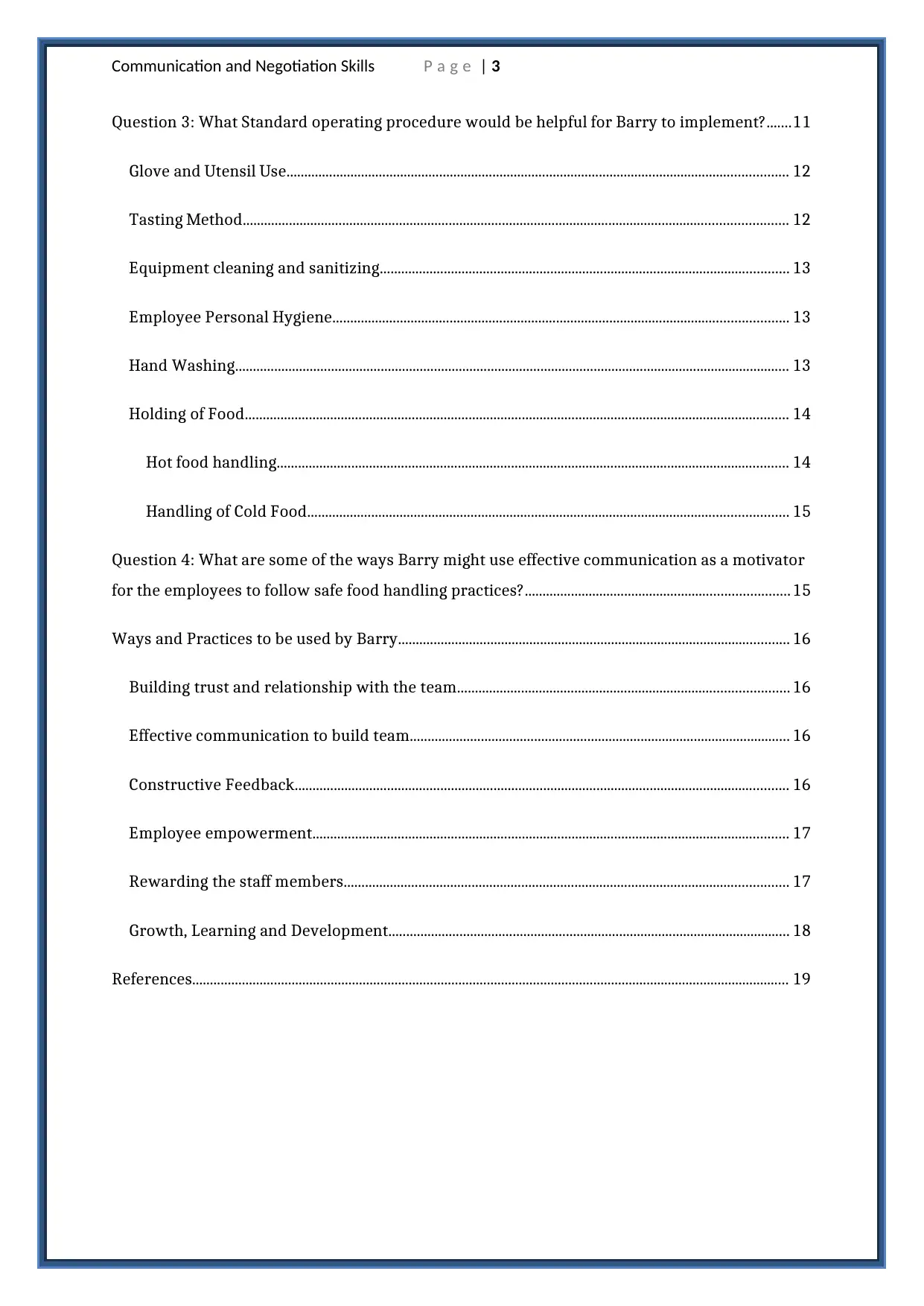
Communication and Negotiation Skills P a g e | 3
Question 3: What Standard operating procedure would be helpful for Barry to implement?.......11
Glove and Utensil Use............................................................................................................................................. 12
Tasting Method......................................................................................................................................................... 12
Equipment cleaning and sanitizing................................................................................................................... 13
Employee Personal Hygiene................................................................................................................................ 13
Hand Washing............................................................................................................................................................ 13
Holding of Food......................................................................................................................................................... 14
Hot food handling................................................................................................................................................ 14
Handling of Cold Food....................................................................................................................................... 15
Question 4: What are some of the ways Barry might use effective communication as a motivator
for the employees to follow safe food handling practices?..........................................................................15
Ways and Practices to be used by Barry.............................................................................................................. 16
Building trust and relationship with the team............................................................................................. 16
Effective communication to build team........................................................................................................... 16
Constructive Feedback........................................................................................................................................... 16
Employee empowerment...................................................................................................................................... 17
Rewarding the staff members............................................................................................................................. 17
Growth, Learning and Development................................................................................................................. 18
References........................................................................................................................................................................ 19
Question 3: What Standard operating procedure would be helpful for Barry to implement?.......11
Glove and Utensil Use............................................................................................................................................. 12
Tasting Method......................................................................................................................................................... 12
Equipment cleaning and sanitizing................................................................................................................... 13
Employee Personal Hygiene................................................................................................................................ 13
Hand Washing............................................................................................................................................................ 13
Holding of Food......................................................................................................................................................... 14
Hot food handling................................................................................................................................................ 14
Handling of Cold Food....................................................................................................................................... 15
Question 4: What are some of the ways Barry might use effective communication as a motivator
for the employees to follow safe food handling practices?..........................................................................15
Ways and Practices to be used by Barry.............................................................................................................. 16
Building trust and relationship with the team............................................................................................. 16
Effective communication to build team........................................................................................................... 16
Constructive Feedback........................................................................................................................................... 16
Employee empowerment...................................................................................................................................... 17
Rewarding the staff members............................................................................................................................. 17
Growth, Learning and Development................................................................................................................. 18
References........................................................................................................................................................................ 19
Secure Best Marks with AI Grader
Need help grading? Try our AI Grader for instant feedback on your assignments.
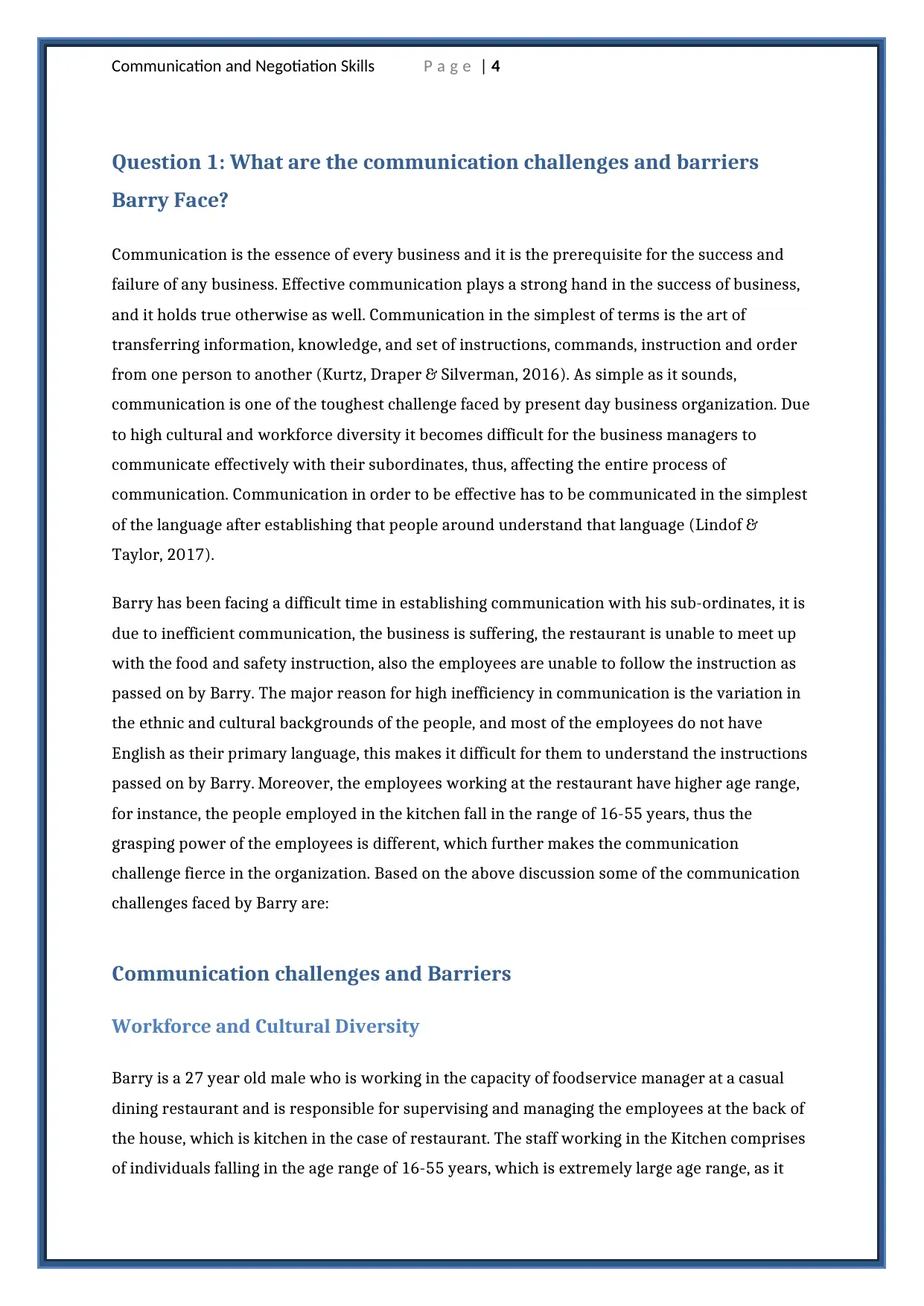
Communication and Negotiation Skills P a g e | 4
Question 1: What are the communication challenges and barriers
Barry Face?
Communication is the essence of every business and it is the prerequisite for the success and
failure of any business. Effective communication plays a strong hand in the success of business,
and it holds true otherwise as well. Communication in the simplest of terms is the art of
transferring information, knowledge, and set of instructions, commands, instruction and order
from one person to another (Kurtz, Draper & Silverman, 2016). As simple as it sounds,
communication is one of the toughest challenge faced by present day business organization. Due
to high cultural and workforce diversity it becomes difficult for the business managers to
communicate effectively with their subordinates, thus, affecting the entire process of
communication. Communication in order to be effective has to be communicated in the simplest
of the language after establishing that people around understand that language (Lindof &
Taylor, 2017).
Barry has been facing a difficult time in establishing communication with his sub-ordinates, it is
due to inefficient communication, the business is suffering, the restaurant is unable to meet up
with the food and safety instruction, also the employees are unable to follow the instruction as
passed on by Barry. The major reason for high inefficiency in communication is the variation in
the ethnic and cultural backgrounds of the people, and most of the employees do not have
English as their primary language, this makes it difficult for them to understand the instructions
passed on by Barry. Moreover, the employees working at the restaurant have higher age range,
for instance, the people employed in the kitchen fall in the range of 16-55 years, thus the
grasping power of the employees is different, which further makes the communication
challenge fierce in the organization. Based on the above discussion some of the communication
challenges faced by Barry are:
Communication challenges and Barriers
Workforce and Cultural Diversity
Barry is a 27 year old male who is working in the capacity of foodservice manager at a casual
dining restaurant and is responsible for supervising and managing the employees at the back of
the house, which is kitchen in the case of restaurant. The staff working in the Kitchen comprises
of individuals falling in the age range of 16-55 years, which is extremely large age range, as it
Question 1: What are the communication challenges and barriers
Barry Face?
Communication is the essence of every business and it is the prerequisite for the success and
failure of any business. Effective communication plays a strong hand in the success of business,
and it holds true otherwise as well. Communication in the simplest of terms is the art of
transferring information, knowledge, and set of instructions, commands, instruction and order
from one person to another (Kurtz, Draper & Silverman, 2016). As simple as it sounds,
communication is one of the toughest challenge faced by present day business organization. Due
to high cultural and workforce diversity it becomes difficult for the business managers to
communicate effectively with their subordinates, thus, affecting the entire process of
communication. Communication in order to be effective has to be communicated in the simplest
of the language after establishing that people around understand that language (Lindof &
Taylor, 2017).
Barry has been facing a difficult time in establishing communication with his sub-ordinates, it is
due to inefficient communication, the business is suffering, the restaurant is unable to meet up
with the food and safety instruction, also the employees are unable to follow the instruction as
passed on by Barry. The major reason for high inefficiency in communication is the variation in
the ethnic and cultural backgrounds of the people, and most of the employees do not have
English as their primary language, this makes it difficult for them to understand the instructions
passed on by Barry. Moreover, the employees working at the restaurant have higher age range,
for instance, the people employed in the kitchen fall in the range of 16-55 years, thus the
grasping power of the employees is different, which further makes the communication
challenge fierce in the organization. Based on the above discussion some of the communication
challenges faced by Barry are:
Communication challenges and Barriers
Workforce and Cultural Diversity
Barry is a 27 year old male who is working in the capacity of foodservice manager at a casual
dining restaurant and is responsible for supervising and managing the employees at the back of
the house, which is kitchen in the case of restaurant. The staff working in the Kitchen comprises
of individuals falling in the age range of 16-55 years, which is extremely large age range, as it

Communication and Negotiation Skills P a g e | 5
comprises all the possible range of population, millennial, mid age people and old age people as
well. Due to this high age difference Barry at times finds it difficult to communicate with the
employees, which leads to plethora of troubles in the kitchen. At the very same time, most of the
working staff in the kitchen does not have English as their primary language, which is another
big challenge, as Barry who is the kitchen manager has English as his primary language. Staff
working in the kitchen belongs to different parts of the world and from different section of the
society, due to this high cultural, ethnic and language differences, Barry faces trouble in
communicating with the staff members, which is significantly hampering the operation inside
the kitchen and numerous violation of Food safety.
English not being the Primary Language
Barry is the Food and service manager at one of the highly acclaimed restaurant who is
responsible for managing and supervising the operations in the kitchen as well to manage the
kitchen staff. Barry’s Primary language is known to be English, but due to differences in the
culture and ethnicities, majority of the staff does not have English as their primary or native
language. This is one of the biggest communication challenge faced by Barry, as it really
becomes next to impossible to establish a communication or convey a message to the staff if the
language is not being comprehended with the people on the other side. Due to this difficulty,
nuisance is the order of the house in the kitchen. The essential thing in effective communication
is to have the common language, common language helps in better understanding of instruction
or the commands and sets the tone of the entire message, in absence of it, and it is a situation of
total mayhem in the Kitchen.
High turnover at the Restaurant
Employee turnover is the exit of employees voluntarily without any notice or giving a chance to
the management to handle their grievances and make them stick in the organization. Employee
turnover is a huge loss to the organization, as the entire resources deployed in training of the
staff, and the time consumed in making them learn the entire business process, policies and the
functionalities goes down the drain. Thus, employee turnover can be seen as a big negative
point for the organization and efforts has to be made to avoid the same at all costs. The
restaurant is clouded by the same problem, due to high turnover; Barry is unable to give in the
required hours of training to its employees, which leads to difficulty in establishing
communication with them. The staffs are sent half-baked to work on the floor and in kitchen
because of fewer workforces, thus creating troubles. In the absence of the required number of
training hours, the workers are unable to grasp the communication, unable to grasp the
comprises all the possible range of population, millennial, mid age people and old age people as
well. Due to this high age difference Barry at times finds it difficult to communicate with the
employees, which leads to plethora of troubles in the kitchen. At the very same time, most of the
working staff in the kitchen does not have English as their primary language, which is another
big challenge, as Barry who is the kitchen manager has English as his primary language. Staff
working in the kitchen belongs to different parts of the world and from different section of the
society, due to this high cultural, ethnic and language differences, Barry faces trouble in
communicating with the staff members, which is significantly hampering the operation inside
the kitchen and numerous violation of Food safety.
English not being the Primary Language
Barry is the Food and service manager at one of the highly acclaimed restaurant who is
responsible for managing and supervising the operations in the kitchen as well to manage the
kitchen staff. Barry’s Primary language is known to be English, but due to differences in the
culture and ethnicities, majority of the staff does not have English as their primary or native
language. This is one of the biggest communication challenge faced by Barry, as it really
becomes next to impossible to establish a communication or convey a message to the staff if the
language is not being comprehended with the people on the other side. Due to this difficulty,
nuisance is the order of the house in the kitchen. The essential thing in effective communication
is to have the common language, common language helps in better understanding of instruction
or the commands and sets the tone of the entire message, in absence of it, and it is a situation of
total mayhem in the Kitchen.
High turnover at the Restaurant
Employee turnover is the exit of employees voluntarily without any notice or giving a chance to
the management to handle their grievances and make them stick in the organization. Employee
turnover is a huge loss to the organization, as the entire resources deployed in training of the
staff, and the time consumed in making them learn the entire business process, policies and the
functionalities goes down the drain. Thus, employee turnover can be seen as a big negative
point for the organization and efforts has to be made to avoid the same at all costs. The
restaurant is clouded by the same problem, due to high turnover; Barry is unable to give in the
required hours of training to its employees, which leads to difficulty in establishing
communication with them. The staffs are sent half-baked to work on the floor and in kitchen
because of fewer workforces, thus creating troubles. In the absence of the required number of
training hours, the workers are unable to grasp the communication, unable to grasp the
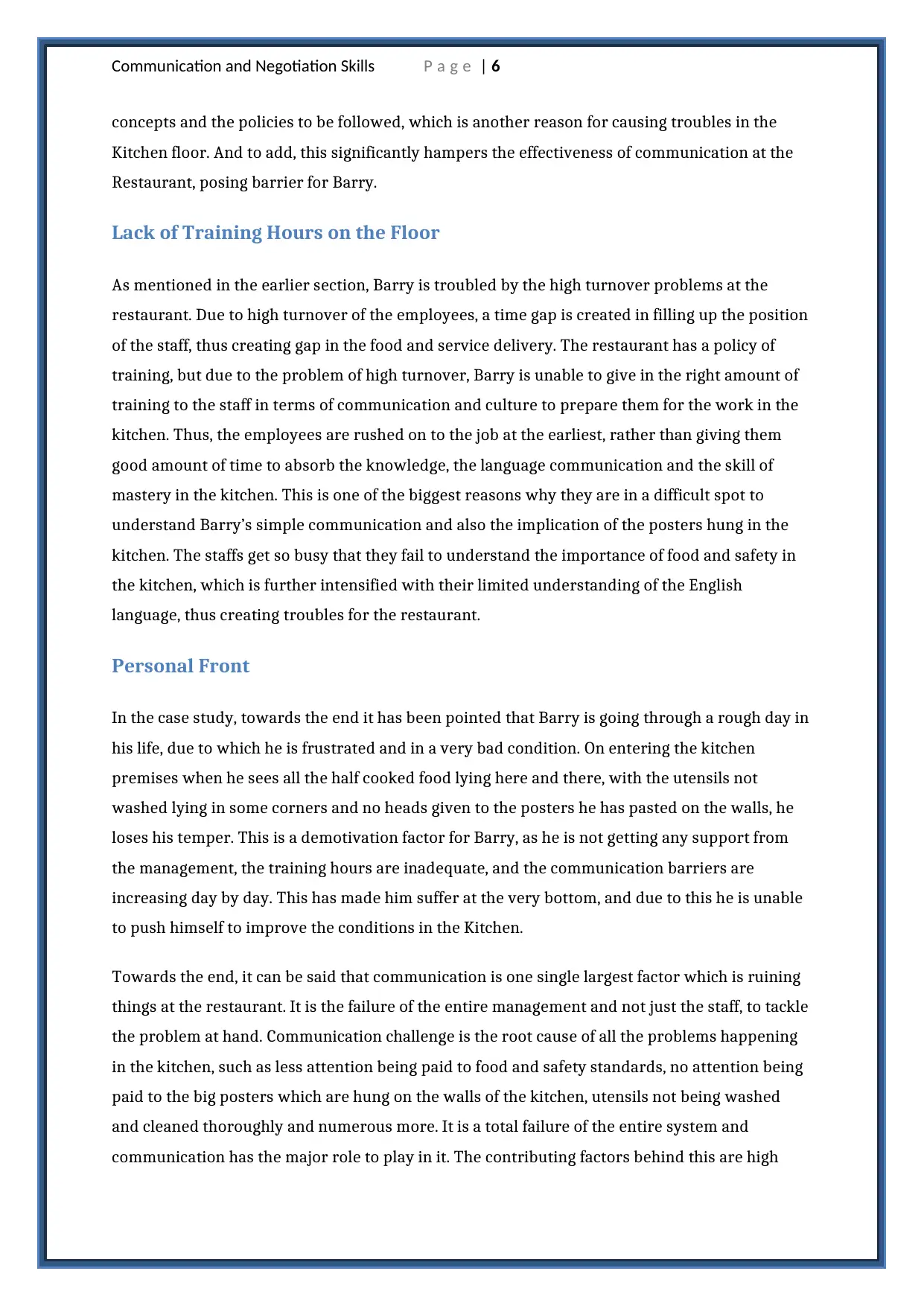
Communication and Negotiation Skills P a g e | 6
concepts and the policies to be followed, which is another reason for causing troubles in the
Kitchen floor. And to add, this significantly hampers the effectiveness of communication at the
Restaurant, posing barrier for Barry.
Lack of Training Hours on the Floor
As mentioned in the earlier section, Barry is troubled by the high turnover problems at the
restaurant. Due to high turnover of the employees, a time gap is created in filling up the position
of the staff, thus creating gap in the food and service delivery. The restaurant has a policy of
training, but due to the problem of high turnover, Barry is unable to give in the right amount of
training to the staff in terms of communication and culture to prepare them for the work in the
kitchen. Thus, the employees are rushed on to the job at the earliest, rather than giving them
good amount of time to absorb the knowledge, the language communication and the skill of
mastery in the kitchen. This is one of the biggest reasons why they are in a difficult spot to
understand Barry’s simple communication and also the implication of the posters hung in the
kitchen. The staffs get so busy that they fail to understand the importance of food and safety in
the kitchen, which is further intensified with their limited understanding of the English
language, thus creating troubles for the restaurant.
Personal Front
In the case study, towards the end it has been pointed that Barry is going through a rough day in
his life, due to which he is frustrated and in a very bad condition. On entering the kitchen
premises when he sees all the half cooked food lying here and there, with the utensils not
washed lying in some corners and no heads given to the posters he has pasted on the walls, he
loses his temper. This is a demotivation factor for Barry, as he is not getting any support from
the management, the training hours are inadequate, and the communication barriers are
increasing day by day. This has made him suffer at the very bottom, and due to this he is unable
to push himself to improve the conditions in the Kitchen.
Towards the end, it can be said that communication is one single largest factor which is ruining
things at the restaurant. It is the failure of the entire management and not just the staff, to tackle
the problem at hand. Communication challenge is the root cause of all the problems happening
in the kitchen, such as less attention being paid to food and safety standards, no attention being
paid to the big posters which are hung on the walls of the kitchen, utensils not being washed
and cleaned thoroughly and numerous more. It is a total failure of the entire system and
communication has the major role to play in it. The contributing factors behind this are high
concepts and the policies to be followed, which is another reason for causing troubles in the
Kitchen floor. And to add, this significantly hampers the effectiveness of communication at the
Restaurant, posing barrier for Barry.
Lack of Training Hours on the Floor
As mentioned in the earlier section, Barry is troubled by the high turnover problems at the
restaurant. Due to high turnover of the employees, a time gap is created in filling up the position
of the staff, thus creating gap in the food and service delivery. The restaurant has a policy of
training, but due to the problem of high turnover, Barry is unable to give in the right amount of
training to the staff in terms of communication and culture to prepare them for the work in the
kitchen. Thus, the employees are rushed on to the job at the earliest, rather than giving them
good amount of time to absorb the knowledge, the language communication and the skill of
mastery in the kitchen. This is one of the biggest reasons why they are in a difficult spot to
understand Barry’s simple communication and also the implication of the posters hung in the
kitchen. The staffs get so busy that they fail to understand the importance of food and safety in
the kitchen, which is further intensified with their limited understanding of the English
language, thus creating troubles for the restaurant.
Personal Front
In the case study, towards the end it has been pointed that Barry is going through a rough day in
his life, due to which he is frustrated and in a very bad condition. On entering the kitchen
premises when he sees all the half cooked food lying here and there, with the utensils not
washed lying in some corners and no heads given to the posters he has pasted on the walls, he
loses his temper. This is a demotivation factor for Barry, as he is not getting any support from
the management, the training hours are inadequate, and the communication barriers are
increasing day by day. This has made him suffer at the very bottom, and due to this he is unable
to push himself to improve the conditions in the Kitchen.
Towards the end, it can be said that communication is one single largest factor which is ruining
things at the restaurant. It is the failure of the entire management and not just the staff, to tackle
the problem at hand. Communication challenge is the root cause of all the problems happening
in the kitchen, such as less attention being paid to food and safety standards, no attention being
paid to the big posters which are hung on the walls of the kitchen, utensils not being washed
and cleaned thoroughly and numerous more. It is a total failure of the entire system and
communication has the major role to play in it. The contributing factors behind this are high
Paraphrase This Document
Need a fresh take? Get an instant paraphrase of this document with our AI Paraphraser

Communication and Negotiation Skills P a g e | 7
turnover, English not being the primary language and inadequate number of hours for training,
are the obstacles in the way of effective communication. High workforce diversity is a plus point
for the restaurant, but in this case, it is a downside, as people don’t have English as their
primary language. More, so, the people working in the kitchen have a lot of age gap, this can
seriously impact their learning abilities, which put them a step back while learning and picking
up a new language.
Barry on the other hand seems tired of this entire process of trying hard to deliver the best
training, instructions to improve the food and safety practices in the kitchen, but seeing that no
matter the number of hours he is putting in with the staff, he is unable to see any improvement
in the system. It is high time now that the management and Barry takes steps in mending the
situation and improve the communication scenario in the organization. The restaurant is at a
stage where even one of the mistakes in terms of food and safety could lead to shut down of the
store, thus to prevent any such damages from happening, Barry will have to come up with
strategies in order to improve the communication in the organization. The onus is both on Barry
and rest of the staff, to understand the gravity of situation and act accordingly. Communication
has to be highly effective to ensure the success of the goals and objectives of the restaurant.
Question 2: What solution might Barry consider in addressing each of
these challenges and barriers?
As mentioned in the earlier section, Barry is struggling to establish good communication system
in the restaurant due to plethora of problems he has been facing with the employees. The
problems are predominantly due to the difference in ethnicities and cultural background, which
is the reason for their language differences. Majority of the staff is unable to follow the orders,
instruction of Barry just because English is not their primary language. The hours allocated for
language training are less due to the problem of high turnover at the facility, so the employees
have to be sent on the floor half baked. Due to all this reasons the restaurant is unable to meet
up with the standards of food and hygiene safety. Thus, it is high time that Barry strategizes and
evaluates his option to work on the challenges he has been facing at the restaurant. After a clear
evaluation and analysis of the situation at hand, the solution Barry can consider are as follows:
turnover, English not being the primary language and inadequate number of hours for training,
are the obstacles in the way of effective communication. High workforce diversity is a plus point
for the restaurant, but in this case, it is a downside, as people don’t have English as their
primary language. More, so, the people working in the kitchen have a lot of age gap, this can
seriously impact their learning abilities, which put them a step back while learning and picking
up a new language.
Barry on the other hand seems tired of this entire process of trying hard to deliver the best
training, instructions to improve the food and safety practices in the kitchen, but seeing that no
matter the number of hours he is putting in with the staff, he is unable to see any improvement
in the system. It is high time now that the management and Barry takes steps in mending the
situation and improve the communication scenario in the organization. The restaurant is at a
stage where even one of the mistakes in terms of food and safety could lead to shut down of the
store, thus to prevent any such damages from happening, Barry will have to come up with
strategies in order to improve the communication in the organization. The onus is both on Barry
and rest of the staff, to understand the gravity of situation and act accordingly. Communication
has to be highly effective to ensure the success of the goals and objectives of the restaurant.
Question 2: What solution might Barry consider in addressing each of
these challenges and barriers?
As mentioned in the earlier section, Barry is struggling to establish good communication system
in the restaurant due to plethora of problems he has been facing with the employees. The
problems are predominantly due to the difference in ethnicities and cultural background, which
is the reason for their language differences. Majority of the staff is unable to follow the orders,
instruction of Barry just because English is not their primary language. The hours allocated for
language training are less due to the problem of high turnover at the facility, so the employees
have to be sent on the floor half baked. Due to all this reasons the restaurant is unable to meet
up with the standards of food and hygiene safety. Thus, it is high time that Barry strategizes and
evaluates his option to work on the challenges he has been facing at the restaurant. After a clear
evaluation and analysis of the situation at hand, the solution Barry can consider are as follows:
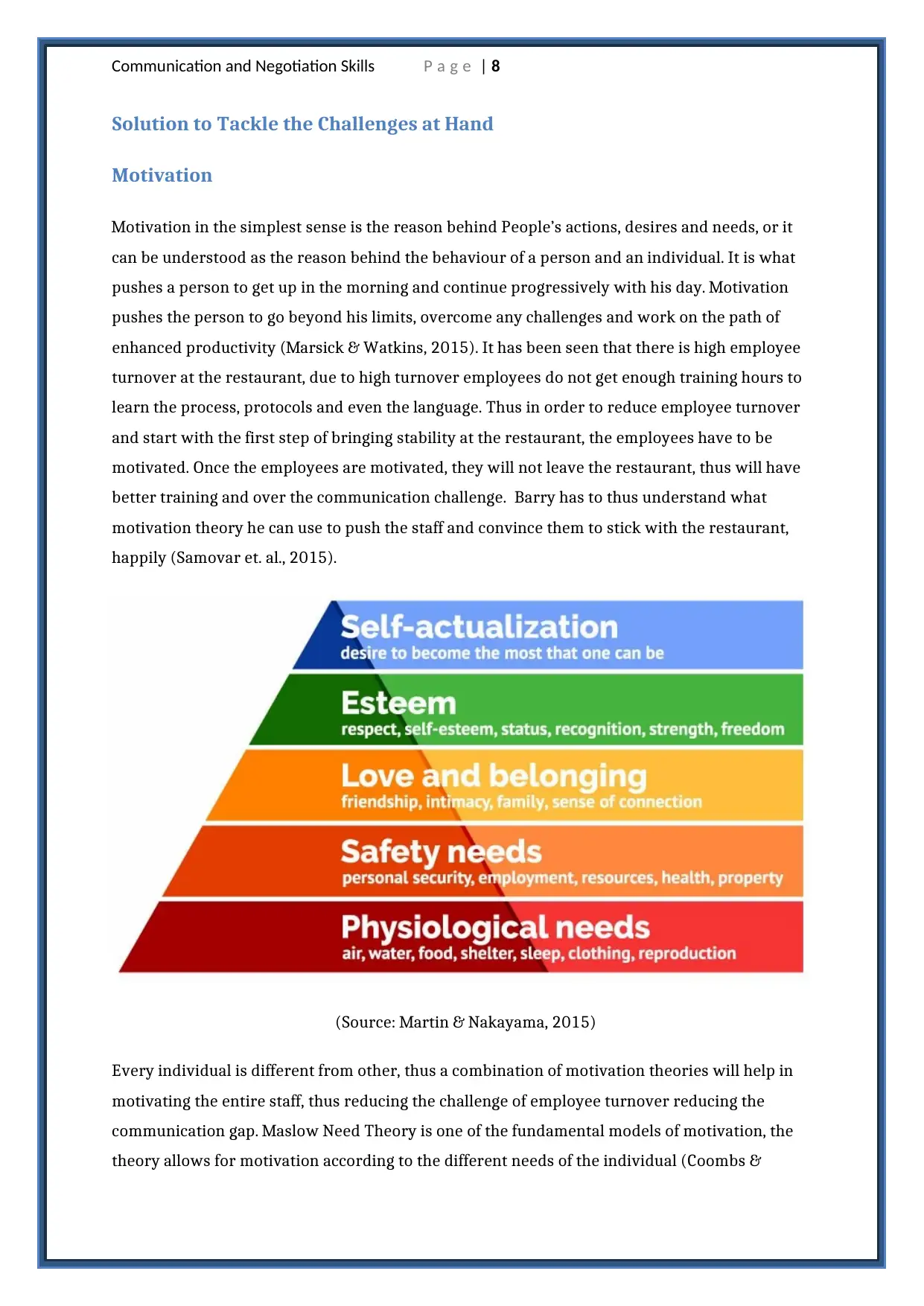
Communication and Negotiation Skills P a g e | 8
Solution to Tackle the Challenges at Hand
Motivation
Motivation in the simplest sense is the reason behind People’s actions, desires and needs, or it
can be understood as the reason behind the behaviour of a person and an individual. It is what
pushes a person to get up in the morning and continue progressively with his day. Motivation
pushes the person to go beyond his limits, overcome any challenges and work on the path of
enhanced productivity (Marsick & Watkins, 2015). It has been seen that there is high employee
turnover at the restaurant, due to high turnover employees do not get enough training hours to
learn the process, protocols and even the language. Thus in order to reduce employee turnover
and start with the first step of bringing stability at the restaurant, the employees have to be
motivated. Once the employees are motivated, they will not leave the restaurant, thus will have
better training and over the communication challenge. Barry has to thus understand what
motivation theory he can use to push the staff and convince them to stick with the restaurant,
happily (Samovar et. al., 2015).
(Source: Martin & Nakayama, 2015)
Every individual is different from other, thus a combination of motivation theories will help in
motivating the entire staff, thus reducing the challenge of employee turnover reducing the
communication gap. Maslow Need Theory is one of the fundamental models of motivation, the
theory allows for motivation according to the different needs of the individual (Coombs &
Solution to Tackle the Challenges at Hand
Motivation
Motivation in the simplest sense is the reason behind People’s actions, desires and needs, or it
can be understood as the reason behind the behaviour of a person and an individual. It is what
pushes a person to get up in the morning and continue progressively with his day. Motivation
pushes the person to go beyond his limits, overcome any challenges and work on the path of
enhanced productivity (Marsick & Watkins, 2015). It has been seen that there is high employee
turnover at the restaurant, due to high turnover employees do not get enough training hours to
learn the process, protocols and even the language. Thus in order to reduce employee turnover
and start with the first step of bringing stability at the restaurant, the employees have to be
motivated. Once the employees are motivated, they will not leave the restaurant, thus will have
better training and over the communication challenge. Barry has to thus understand what
motivation theory he can use to push the staff and convince them to stick with the restaurant,
happily (Samovar et. al., 2015).
(Source: Martin & Nakayama, 2015)
Every individual is different from other, thus a combination of motivation theories will help in
motivating the entire staff, thus reducing the challenge of employee turnover reducing the
communication gap. Maslow Need Theory is one of the fundamental models of motivation, the
theory allows for motivation according to the different needs of the individual (Coombs &

Communication and Negotiation Skills P a g e | 9
Holladay, 2015). For example, Physiological needs societal needs, social esteem needs and self-
actualization needs. Similarly in other way, Barry can use two factor theories to identify the
hygiene factors and motivation factors in the organization. This way, he can reduce the hygiene
factors and increase the motivation factors for the employees. More motivation theories such as
Adam Theory, Vroom expectancy Theory, Hertzberg factor theory can be used to motivate the
employees at the restaurant. The bottom-line here is, to keep the employees happy, motivated
and satisfied to work productively for the restaurant (Binder, 2016).
Adequate training
It has been mentioned in the case study that employees are unable to get adequate training in
terms of communication and other modules of food and safety in the kitchen. The lack in
training is another big challenge faced by the organization. The first step towards the training
exercise is identification of the training needs of the employees and maps it in accordance to the
skills required for the job (Katzenbach & Smith, 2015). The gap identified by the Current skills
and Required skills for the job will help in understanding the training need of the
individual .This scientific exercise will not only help the organization to come up with better
training calendars and module for the employees, at the same time it will assist the employees
to enhance their learning by polishing the skills they have been lacking at (Holmes & Stubbe,
2015). Training need analysis will make the employees also understand the skills they have to
master for their own professional and personal development. Thus, adequate training hours will
bring stability in the organization and do away with the challenges Barry has been facing at
present. Moreover it will also help the employees to work in an environment of learning, growth
and development which will act as motivation for them (Barak, 2016).
Communication Training
The biggest gap or the lacuna in the success of the restaurant is inability of Barry and his staff to
establish proper communication in the Kitchen. It is the inability of the staff to understand the
English language which makes it difficult for them to follow the instructions and orders of Barry.
This situation has to be changed at the earliest, or the restaurant will be doomed at a very
nascent stage (Kaushal & Kaddoum, 2015). Thus, in order to do so, communication training only
for English language has to be started in the restaurant. The training should focus on the basic
modules of English and focus on step by step learning and development of the language skill in
the staff. Thus, communication training will ensure that the staffs get well versed with the
language and are in a position to respond to the instruction of Barry and follow them for the
good of Restaurant and themselves (Brink & Costigan, 2015).
Holladay, 2015). For example, Physiological needs societal needs, social esteem needs and self-
actualization needs. Similarly in other way, Barry can use two factor theories to identify the
hygiene factors and motivation factors in the organization. This way, he can reduce the hygiene
factors and increase the motivation factors for the employees. More motivation theories such as
Adam Theory, Vroom expectancy Theory, Hertzberg factor theory can be used to motivate the
employees at the restaurant. The bottom-line here is, to keep the employees happy, motivated
and satisfied to work productively for the restaurant (Binder, 2016).
Adequate training
It has been mentioned in the case study that employees are unable to get adequate training in
terms of communication and other modules of food and safety in the kitchen. The lack in
training is another big challenge faced by the organization. The first step towards the training
exercise is identification of the training needs of the employees and maps it in accordance to the
skills required for the job (Katzenbach & Smith, 2015). The gap identified by the Current skills
and Required skills for the job will help in understanding the training need of the
individual .This scientific exercise will not only help the organization to come up with better
training calendars and module for the employees, at the same time it will assist the employees
to enhance their learning by polishing the skills they have been lacking at (Holmes & Stubbe,
2015). Training need analysis will make the employees also understand the skills they have to
master for their own professional and personal development. Thus, adequate training hours will
bring stability in the organization and do away with the challenges Barry has been facing at
present. Moreover it will also help the employees to work in an environment of learning, growth
and development which will act as motivation for them (Barak, 2016).
Communication Training
The biggest gap or the lacuna in the success of the restaurant is inability of Barry and his staff to
establish proper communication in the Kitchen. It is the inability of the staff to understand the
English language which makes it difficult for them to follow the instructions and orders of Barry.
This situation has to be changed at the earliest, or the restaurant will be doomed at a very
nascent stage (Kaushal & Kaddoum, 2015). Thus, in order to do so, communication training only
for English language has to be started in the restaurant. The training should focus on the basic
modules of English and focus on step by step learning and development of the language skill in
the staff. Thus, communication training will ensure that the staffs get well versed with the
language and are in a position to respond to the instruction of Barry and follow them for the
good of Restaurant and themselves (Brink & Costigan, 2015).
Secure Best Marks with AI Grader
Need help grading? Try our AI Grader for instant feedback on your assignments.
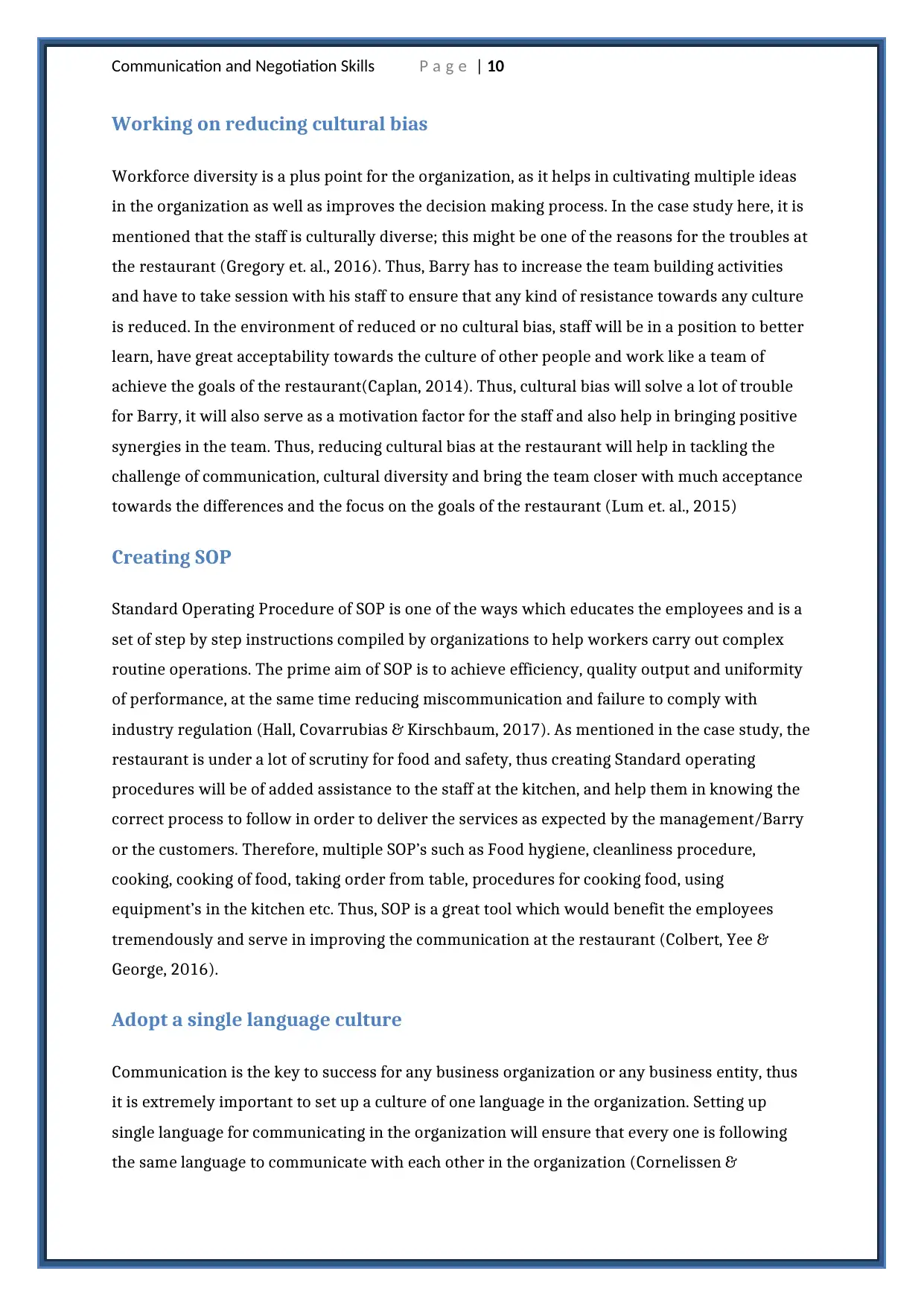
Communication and Negotiation Skills P a g e | 10
Working on reducing cultural bias
Workforce diversity is a plus point for the organization, as it helps in cultivating multiple ideas
in the organization as well as improves the decision making process. In the case study here, it is
mentioned that the staff is culturally diverse; this might be one of the reasons for the troubles at
the restaurant (Gregory et. al., 2016). Thus, Barry has to increase the team building activities
and have to take session with his staff to ensure that any kind of resistance towards any culture
is reduced. In the environment of reduced or no cultural bias, staff will be in a position to better
learn, have great acceptability towards the culture of other people and work like a team of
achieve the goals of the restaurant(Caplan, 2014). Thus, cultural bias will solve a lot of trouble
for Barry, it will also serve as a motivation factor for the staff and also help in bringing positive
synergies in the team. Thus, reducing cultural bias at the restaurant will help in tackling the
challenge of communication, cultural diversity and bring the team closer with much acceptance
towards the differences and the focus on the goals of the restaurant (Lum et. al., 2015)
Creating SOP
Standard Operating Procedure of SOP is one of the ways which educates the employees and is a
set of step by step instructions compiled by organizations to help workers carry out complex
routine operations. The prime aim of SOP is to achieve efficiency, quality output and uniformity
of performance, at the same time reducing miscommunication and failure to comply with
industry regulation (Hall, Covarrubias & Kirschbaum, 2017). As mentioned in the case study, the
restaurant is under a lot of scrutiny for food and safety, thus creating Standard operating
procedures will be of added assistance to the staff at the kitchen, and help them in knowing the
correct process to follow in order to deliver the services as expected by the management/Barry
or the customers. Therefore, multiple SOP’s such as Food hygiene, cleanliness procedure,
cooking, cooking of food, taking order from table, procedures for cooking food, using
equipment’s in the kitchen etc. Thus, SOP is a great tool which would benefit the employees
tremendously and serve in improving the communication at the restaurant (Colbert, Yee &
George, 2016).
Adopt a single language culture
Communication is the key to success for any business organization or any business entity, thus
it is extremely important to set up a culture of one language in the organization. Setting up
single language for communicating in the organization will ensure that every one is following
the same language to communicate with each other in the organization (Cornelissen &
Working on reducing cultural bias
Workforce diversity is a plus point for the organization, as it helps in cultivating multiple ideas
in the organization as well as improves the decision making process. In the case study here, it is
mentioned that the staff is culturally diverse; this might be one of the reasons for the troubles at
the restaurant (Gregory et. al., 2016). Thus, Barry has to increase the team building activities
and have to take session with his staff to ensure that any kind of resistance towards any culture
is reduced. In the environment of reduced or no cultural bias, staff will be in a position to better
learn, have great acceptability towards the culture of other people and work like a team of
achieve the goals of the restaurant(Caplan, 2014). Thus, cultural bias will solve a lot of trouble
for Barry, it will also serve as a motivation factor for the staff and also help in bringing positive
synergies in the team. Thus, reducing cultural bias at the restaurant will help in tackling the
challenge of communication, cultural diversity and bring the team closer with much acceptance
towards the differences and the focus on the goals of the restaurant (Lum et. al., 2015)
Creating SOP
Standard Operating Procedure of SOP is one of the ways which educates the employees and is a
set of step by step instructions compiled by organizations to help workers carry out complex
routine operations. The prime aim of SOP is to achieve efficiency, quality output and uniformity
of performance, at the same time reducing miscommunication and failure to comply with
industry regulation (Hall, Covarrubias & Kirschbaum, 2017). As mentioned in the case study, the
restaurant is under a lot of scrutiny for food and safety, thus creating Standard operating
procedures will be of added assistance to the staff at the kitchen, and help them in knowing the
correct process to follow in order to deliver the services as expected by the management/Barry
or the customers. Therefore, multiple SOP’s such as Food hygiene, cleanliness procedure,
cooking, cooking of food, taking order from table, procedures for cooking food, using
equipment’s in the kitchen etc. Thus, SOP is a great tool which would benefit the employees
tremendously and serve in improving the communication at the restaurant (Colbert, Yee &
George, 2016).
Adopt a single language culture
Communication is the key to success for any business organization or any business entity, thus
it is extremely important to set up a culture of one language in the organization. Setting up
single language for communicating in the organization will ensure that every one is following
the same language to communicate with each other in the organization (Cornelissen &
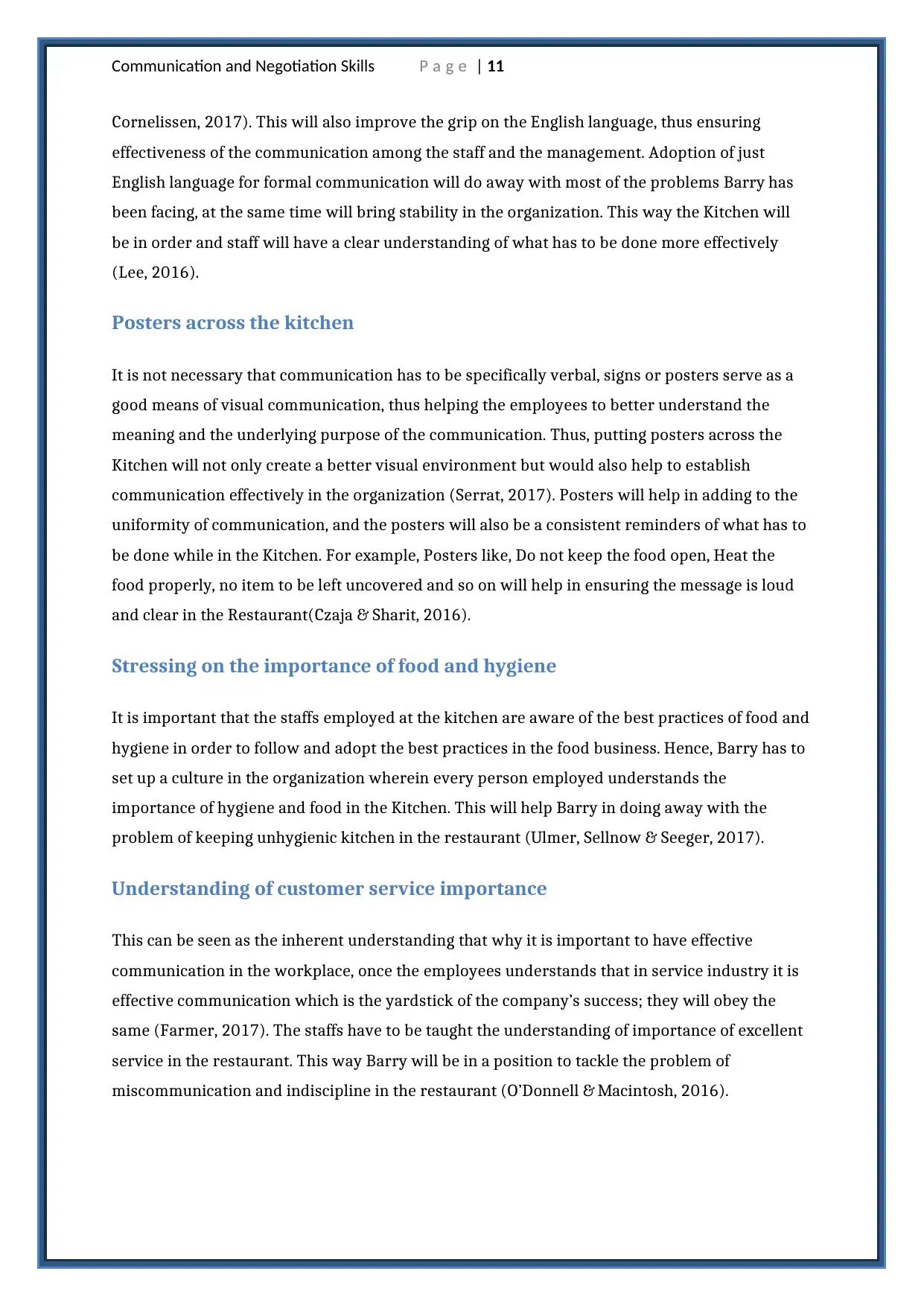
Communication and Negotiation Skills P a g e | 11
Cornelissen, 2017). This will also improve the grip on the English language, thus ensuring
effectiveness of the communication among the staff and the management. Adoption of just
English language for formal communication will do away with most of the problems Barry has
been facing, at the same time will bring stability in the organization. This way the Kitchen will
be in order and staff will have a clear understanding of what has to be done more effectively
(Lee, 2016).
Posters across the kitchen
It is not necessary that communication has to be specifically verbal, signs or posters serve as a
good means of visual communication, thus helping the employees to better understand the
meaning and the underlying purpose of the communication. Thus, putting posters across the
Kitchen will not only create a better visual environment but would also help to establish
communication effectively in the organization (Serrat, 2017). Posters will help in adding to the
uniformity of communication, and the posters will also be a consistent reminders of what has to
be done while in the Kitchen. For example, Posters like, Do not keep the food open, Heat the
food properly, no item to be left uncovered and so on will help in ensuring the message is loud
and clear in the Restaurant(Czaja & Sharit, 2016).
Stressing on the importance of food and hygiene
It is important that the staffs employed at the kitchen are aware of the best practices of food and
hygiene in order to follow and adopt the best practices in the food business. Hence, Barry has to
set up a culture in the organization wherein every person employed understands the
importance of hygiene and food in the Kitchen. This will help Barry in doing away with the
problem of keeping unhygienic kitchen in the restaurant (Ulmer, Sellnow & Seeger, 2017).
Understanding of customer service importance
This can be seen as the inherent understanding that why it is important to have effective
communication in the workplace, once the employees understands that in service industry it is
effective communication which is the yardstick of the company’s success; they will obey the
same (Farmer, 2017). The staffs have to be taught the understanding of importance of excellent
service in the restaurant. This way Barry will be in a position to tackle the problem of
miscommunication and indiscipline in the restaurant (O’Donnell & Macintosh, 2016).
Cornelissen, 2017). This will also improve the grip on the English language, thus ensuring
effectiveness of the communication among the staff and the management. Adoption of just
English language for formal communication will do away with most of the problems Barry has
been facing, at the same time will bring stability in the organization. This way the Kitchen will
be in order and staff will have a clear understanding of what has to be done more effectively
(Lee, 2016).
Posters across the kitchen
It is not necessary that communication has to be specifically verbal, signs or posters serve as a
good means of visual communication, thus helping the employees to better understand the
meaning and the underlying purpose of the communication. Thus, putting posters across the
Kitchen will not only create a better visual environment but would also help to establish
communication effectively in the organization (Serrat, 2017). Posters will help in adding to the
uniformity of communication, and the posters will also be a consistent reminders of what has to
be done while in the Kitchen. For example, Posters like, Do not keep the food open, Heat the
food properly, no item to be left uncovered and so on will help in ensuring the message is loud
and clear in the Restaurant(Czaja & Sharit, 2016).
Stressing on the importance of food and hygiene
It is important that the staffs employed at the kitchen are aware of the best practices of food and
hygiene in order to follow and adopt the best practices in the food business. Hence, Barry has to
set up a culture in the organization wherein every person employed understands the
importance of hygiene and food in the Kitchen. This will help Barry in doing away with the
problem of keeping unhygienic kitchen in the restaurant (Ulmer, Sellnow & Seeger, 2017).
Understanding of customer service importance
This can be seen as the inherent understanding that why it is important to have effective
communication in the workplace, once the employees understands that in service industry it is
effective communication which is the yardstick of the company’s success; they will obey the
same (Farmer, 2017). The staffs have to be taught the understanding of importance of excellent
service in the restaurant. This way Barry will be in a position to tackle the problem of
miscommunication and indiscipline in the restaurant (O’Donnell & Macintosh, 2016).

Communication and Negotiation Skills P a g e | 12
Setting clear goals and expectation
Employees work well in the organization when they have clear goals defined and have a path to
follow; it becomes easier for them to walk the path. Barry has to create goals for the staff, or the
KPI have to be communicated or set for them to make them aware what the organization
expects out of them (Crane & Glozer, 2016). Goal setting Theory, Or SMART goals can be used to
set up the goals of the staff and the goals have to be reviewed and feedback to be shared on the
completion of goals on a consistent basis. This will help Barry in motivating the employees, thus
reducing turnover in the organization (O’Toole, 2016).
Usage of social media
Social media has garnered strong popularity in the last decade. Organizations have understood
the importance of social media for business and are not using the platform to just get business
from their customers but are also being used as a tool to establish communication with the
employees. The ease of using the platform and the openness in platform is what makes social
media a good choice for business organization (Moser, 2016). Barry can use social media
channels to communicate any important instruction, or share some wisdom and knowledge
with the staff members; he can also use the channel to increase the team bonding with his team,
thus developing a relation of trust and faith with the employees. In this way, Barry would be
able to establish a great informal communication channel with the staff members thus reducing
the troubles for the casual dining restaurant (Brownell, 2015).
Question 3: What Standard operating procedure would be helpful for
Barry to implement?
Designing Standard operating procedure for the staff working in the kitchen will be extremely
beneficial not only for the staff, but also help Barry in overcoming the challenges he has been
facing for quite some time. SOP will help the staff to understand the basic practices of Kitchen at
length, which would also serve the as on the job training material. SOP is a procedure which is
highly specific to the business operation and illustrates the activities absolutely necessary in
order to complete the tasks in accordance with the industry regulations, provincial laws or can
be just standard for running one’s own business. In simple terms any piece of document which
falls into the category of “how to” do something is SOP (King & Bedale, 2018).
An SOP defines the expected practices of the business where quality standards hold paramount
importance. SOP for restaurant are extremely important due to high quality and hygiene
Setting clear goals and expectation
Employees work well in the organization when they have clear goals defined and have a path to
follow; it becomes easier for them to walk the path. Barry has to create goals for the staff, or the
KPI have to be communicated or set for them to make them aware what the organization
expects out of them (Crane & Glozer, 2016). Goal setting Theory, Or SMART goals can be used to
set up the goals of the staff and the goals have to be reviewed and feedback to be shared on the
completion of goals on a consistent basis. This will help Barry in motivating the employees, thus
reducing turnover in the organization (O’Toole, 2016).
Usage of social media
Social media has garnered strong popularity in the last decade. Organizations have understood
the importance of social media for business and are not using the platform to just get business
from their customers but are also being used as a tool to establish communication with the
employees. The ease of using the platform and the openness in platform is what makes social
media a good choice for business organization (Moser, 2016). Barry can use social media
channels to communicate any important instruction, or share some wisdom and knowledge
with the staff members; he can also use the channel to increase the team bonding with his team,
thus developing a relation of trust and faith with the employees. In this way, Barry would be
able to establish a great informal communication channel with the staff members thus reducing
the troubles for the casual dining restaurant (Brownell, 2015).
Question 3: What Standard operating procedure would be helpful for
Barry to implement?
Designing Standard operating procedure for the staff working in the kitchen will be extremely
beneficial not only for the staff, but also help Barry in overcoming the challenges he has been
facing for quite some time. SOP will help the staff to understand the basic practices of Kitchen at
length, which would also serve the as on the job training material. SOP is a procedure which is
highly specific to the business operation and illustrates the activities absolutely necessary in
order to complete the tasks in accordance with the industry regulations, provincial laws or can
be just standard for running one’s own business. In simple terms any piece of document which
falls into the category of “how to” do something is SOP (King & Bedale, 2018).
An SOP defines the expected practices of the business where quality standards hold paramount
importance. SOP for restaurant are extremely important due to high quality and hygiene
Paraphrase This Document
Need a fresh take? Get an instant paraphrase of this document with our AI Paraphraser
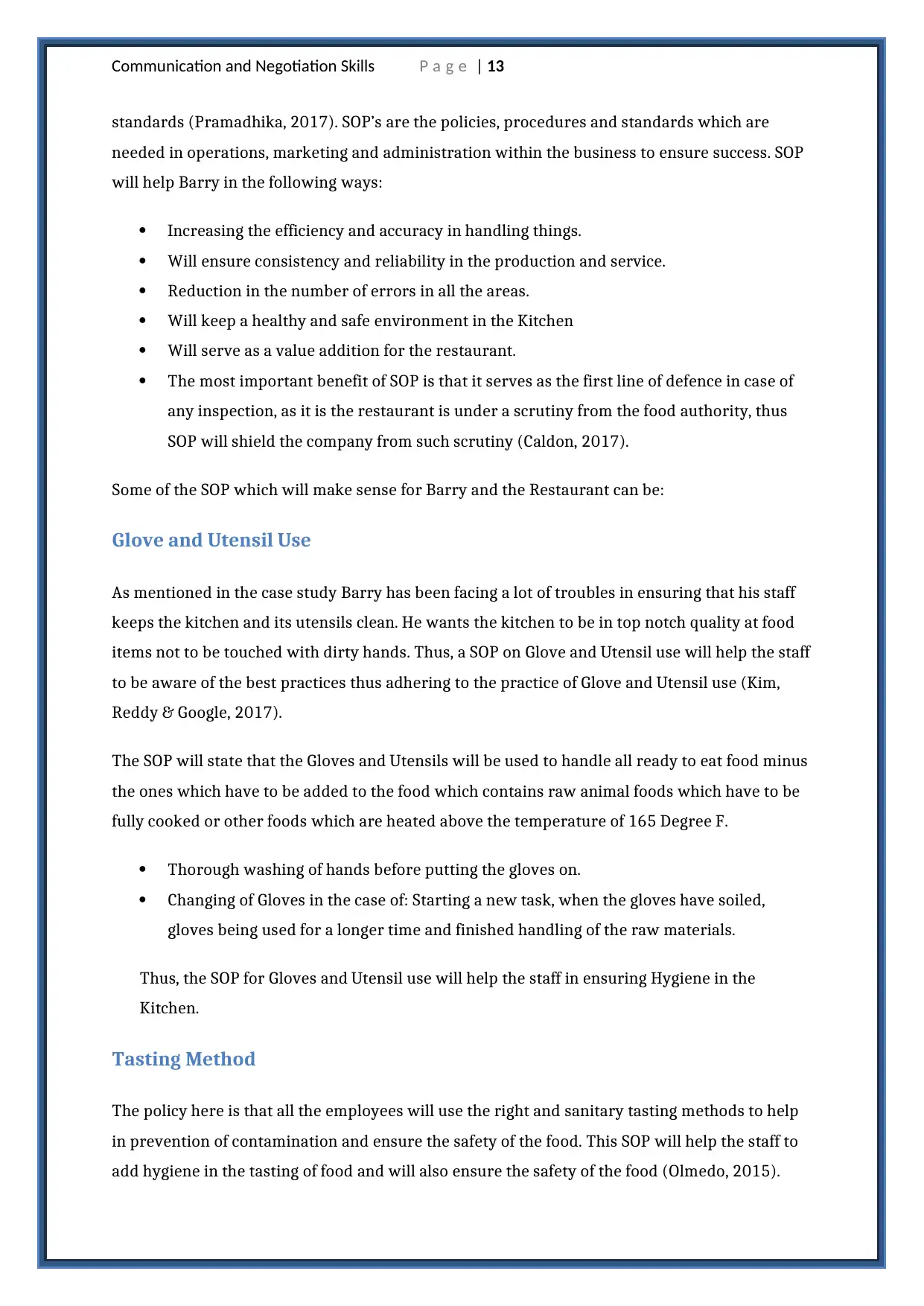
Communication and Negotiation Skills P a g e | 13
standards (Pramadhika, 2017). SOP’s are the policies, procedures and standards which are
needed in operations, marketing and administration within the business to ensure success. SOP
will help Barry in the following ways:
Increasing the efficiency and accuracy in handling things.
Will ensure consistency and reliability in the production and service.
Reduction in the number of errors in all the areas.
Will keep a healthy and safe environment in the Kitchen
Will serve as a value addition for the restaurant.
The most important benefit of SOP is that it serves as the first line of defence in case of
any inspection, as it is the restaurant is under a scrutiny from the food authority, thus
SOP will shield the company from such scrutiny (Caldon, 2017).
Some of the SOP which will make sense for Barry and the Restaurant can be:
Glove and Utensil Use
As mentioned in the case study Barry has been facing a lot of troubles in ensuring that his staff
keeps the kitchen and its utensils clean. He wants the kitchen to be in top notch quality at food
items not to be touched with dirty hands. Thus, a SOP on Glove and Utensil use will help the staff
to be aware of the best practices thus adhering to the practice of Glove and Utensil use (Kim,
Reddy & Google, 2017).
The SOP will state that the Gloves and Utensils will be used to handle all ready to eat food minus
the ones which have to be added to the food which contains raw animal foods which have to be
fully cooked or other foods which are heated above the temperature of 165 Degree F.
Thorough washing of hands before putting the gloves on.
Changing of Gloves in the case of: Starting a new task, when the gloves have soiled,
gloves being used for a longer time and finished handling of the raw materials.
Thus, the SOP for Gloves and Utensil use will help the staff in ensuring Hygiene in the
Kitchen.
Tasting Method
The policy here is that all the employees will use the right and sanitary tasting methods to help
in prevention of contamination and ensure the safety of the food. This SOP will help the staff to
add hygiene in the tasting of food and will also ensure the safety of the food (Olmedo, 2015).
standards (Pramadhika, 2017). SOP’s are the policies, procedures and standards which are
needed in operations, marketing and administration within the business to ensure success. SOP
will help Barry in the following ways:
Increasing the efficiency and accuracy in handling things.
Will ensure consistency and reliability in the production and service.
Reduction in the number of errors in all the areas.
Will keep a healthy and safe environment in the Kitchen
Will serve as a value addition for the restaurant.
The most important benefit of SOP is that it serves as the first line of defence in case of
any inspection, as it is the restaurant is under a scrutiny from the food authority, thus
SOP will shield the company from such scrutiny (Caldon, 2017).
Some of the SOP which will make sense for Barry and the Restaurant can be:
Glove and Utensil Use
As mentioned in the case study Barry has been facing a lot of troubles in ensuring that his staff
keeps the kitchen and its utensils clean. He wants the kitchen to be in top notch quality at food
items not to be touched with dirty hands. Thus, a SOP on Glove and Utensil use will help the staff
to be aware of the best practices thus adhering to the practice of Glove and Utensil use (Kim,
Reddy & Google, 2017).
The SOP will state that the Gloves and Utensils will be used to handle all ready to eat food minus
the ones which have to be added to the food which contains raw animal foods which have to be
fully cooked or other foods which are heated above the temperature of 165 Degree F.
Thorough washing of hands before putting the gloves on.
Changing of Gloves in the case of: Starting a new task, when the gloves have soiled,
gloves being used for a longer time and finished handling of the raw materials.
Thus, the SOP for Gloves and Utensil use will help the staff in ensuring Hygiene in the
Kitchen.
Tasting Method
The policy here is that all the employees will use the right and sanitary tasting methods to help
in prevention of contamination and ensure the safety of the food. This SOP will help the staff to
add hygiene in the tasting of food and will also ensure the safety of the food (Olmedo, 2015).
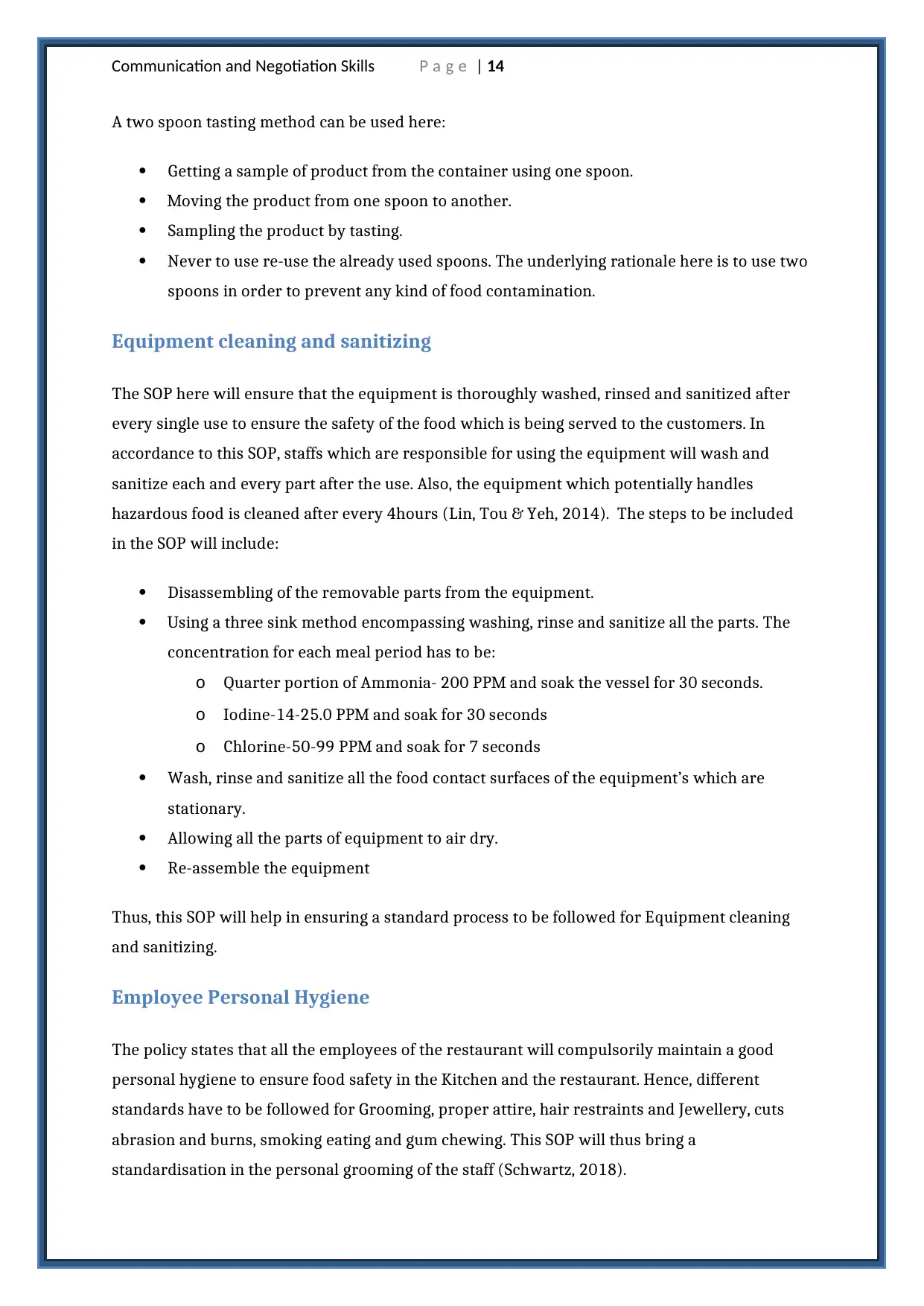
Communication and Negotiation Skills P a g e | 14
A two spoon tasting method can be used here:
Getting a sample of product from the container using one spoon.
Moving the product from one spoon to another.
Sampling the product by tasting.
Never to use re-use the already used spoons. The underlying rationale here is to use two
spoons in order to prevent any kind of food contamination.
Equipment cleaning and sanitizing
The SOP here will ensure that the equipment is thoroughly washed, rinsed and sanitized after
every single use to ensure the safety of the food which is being served to the customers. In
accordance to this SOP, staffs which are responsible for using the equipment will wash and
sanitize each and every part after the use. Also, the equipment which potentially handles
hazardous food is cleaned after every 4hours (Lin, Tou & Yeh, 2014). The steps to be included
in the SOP will include:
Disassembling of the removable parts from the equipment.
Using a three sink method encompassing washing, rinse and sanitize all the parts. The
concentration for each meal period has to be:
o Quarter portion of Ammonia- 200 PPM and soak the vessel for 30 seconds.
o Iodine-14-25.0 PPM and soak for 30 seconds
o Chlorine-50-99 PPM and soak for 7 seconds
Wash, rinse and sanitize all the food contact surfaces of the equipment’s which are
stationary.
Allowing all the parts of equipment to air dry.
Re-assemble the equipment
Thus, this SOP will help in ensuring a standard process to be followed for Equipment cleaning
and sanitizing.
Employee Personal Hygiene
The policy states that all the employees of the restaurant will compulsorily maintain a good
personal hygiene to ensure food safety in the Kitchen and the restaurant. Hence, different
standards have to be followed for Grooming, proper attire, hair restraints and Jewellery, cuts
abrasion and burns, smoking eating and gum chewing. This SOP will thus bring a
standardisation in the personal grooming of the staff (Schwartz, 2018).
A two spoon tasting method can be used here:
Getting a sample of product from the container using one spoon.
Moving the product from one spoon to another.
Sampling the product by tasting.
Never to use re-use the already used spoons. The underlying rationale here is to use two
spoons in order to prevent any kind of food contamination.
Equipment cleaning and sanitizing
The SOP here will ensure that the equipment is thoroughly washed, rinsed and sanitized after
every single use to ensure the safety of the food which is being served to the customers. In
accordance to this SOP, staffs which are responsible for using the equipment will wash and
sanitize each and every part after the use. Also, the equipment which potentially handles
hazardous food is cleaned after every 4hours (Lin, Tou & Yeh, 2014). The steps to be included
in the SOP will include:
Disassembling of the removable parts from the equipment.
Using a three sink method encompassing washing, rinse and sanitize all the parts. The
concentration for each meal period has to be:
o Quarter portion of Ammonia- 200 PPM and soak the vessel for 30 seconds.
o Iodine-14-25.0 PPM and soak for 30 seconds
o Chlorine-50-99 PPM and soak for 7 seconds
Wash, rinse and sanitize all the food contact surfaces of the equipment’s which are
stationary.
Allowing all the parts of equipment to air dry.
Re-assemble the equipment
Thus, this SOP will help in ensuring a standard process to be followed for Equipment cleaning
and sanitizing.
Employee Personal Hygiene
The policy states that all the employees of the restaurant will compulsorily maintain a good
personal hygiene to ensure food safety in the Kitchen and the restaurant. Hence, different
standards have to be followed for Grooming, proper attire, hair restraints and Jewellery, cuts
abrasion and burns, smoking eating and gum chewing. This SOP will thus bring a
standardisation in the personal grooming of the staff (Schwartz, 2018).
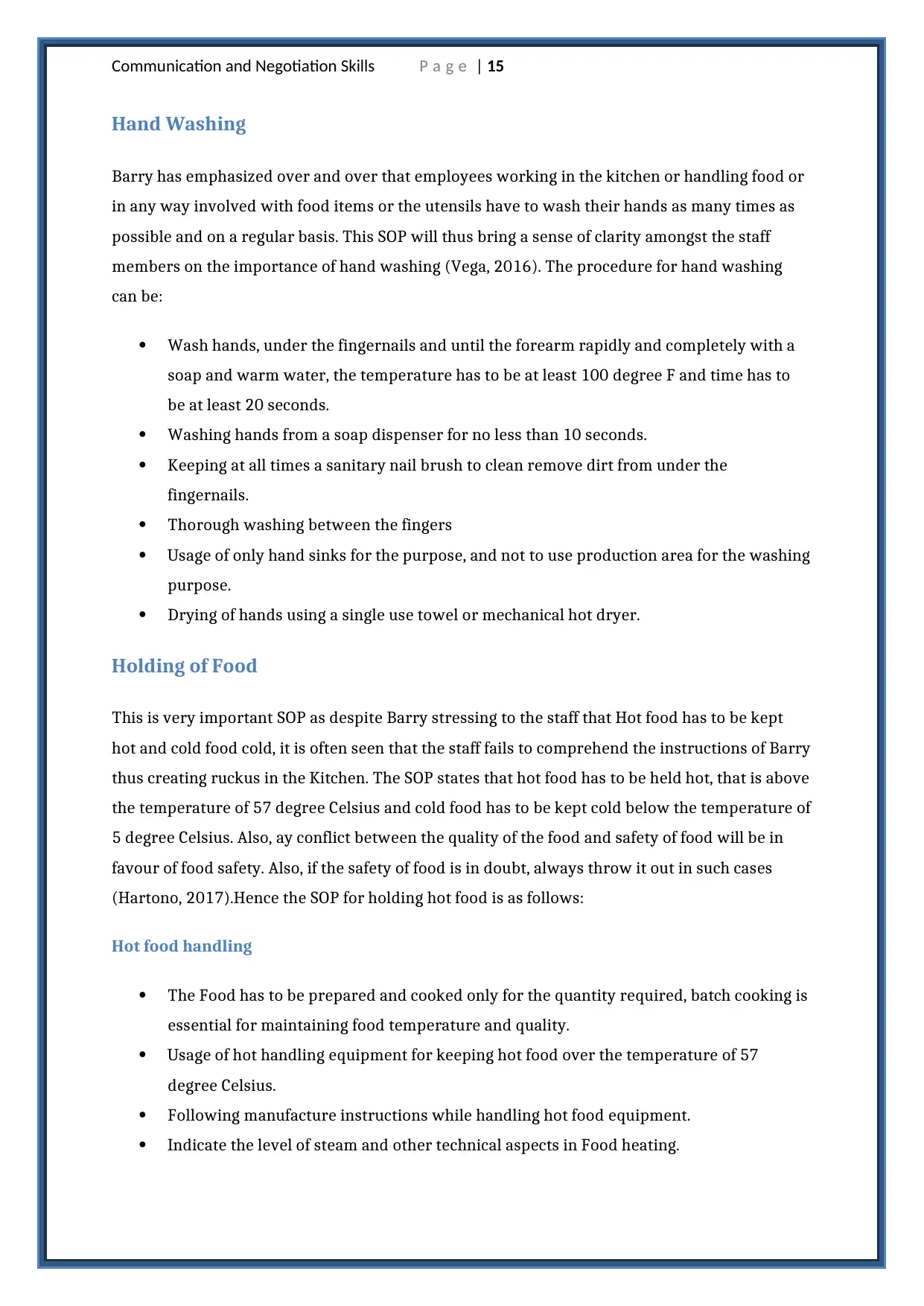
Communication and Negotiation Skills P a g e | 15
Hand Washing
Barry has emphasized over and over that employees working in the kitchen or handling food or
in any way involved with food items or the utensils have to wash their hands as many times as
possible and on a regular basis. This SOP will thus bring a sense of clarity amongst the staff
members on the importance of hand washing (Vega, 2016). The procedure for hand washing
can be:
Wash hands, under the fingernails and until the forearm rapidly and completely with a
soap and warm water, the temperature has to be at least 100 degree F and time has to
be at least 20 seconds.
Washing hands from a soap dispenser for no less than 10 seconds.
Keeping at all times a sanitary nail brush to clean remove dirt from under the
fingernails.
Thorough washing between the fingers
Usage of only hand sinks for the purpose, and not to use production area for the washing
purpose.
Drying of hands using a single use towel or mechanical hot dryer.
Holding of Food
This is very important SOP as despite Barry stressing to the staff that Hot food has to be kept
hot and cold food cold, it is often seen that the staff fails to comprehend the instructions of Barry
thus creating ruckus in the Kitchen. The SOP states that hot food has to be held hot, that is above
the temperature of 57 degree Celsius and cold food has to be kept cold below the temperature of
5 degree Celsius. Also, ay conflict between the quality of the food and safety of food will be in
favour of food safety. Also, if the safety of food is in doubt, always throw it out in such cases
(Hartono, 2017).Hence the SOP for holding hot food is as follows:
Hot food handling
The Food has to be prepared and cooked only for the quantity required, batch cooking is
essential for maintaining food temperature and quality.
Usage of hot handling equipment for keeping hot food over the temperature of 57
degree Celsius.
Following manufacture instructions while handling hot food equipment.
Indicate the level of steam and other technical aspects in Food heating.
Hand Washing
Barry has emphasized over and over that employees working in the kitchen or handling food or
in any way involved with food items or the utensils have to wash their hands as many times as
possible and on a regular basis. This SOP will thus bring a sense of clarity amongst the staff
members on the importance of hand washing (Vega, 2016). The procedure for hand washing
can be:
Wash hands, under the fingernails and until the forearm rapidly and completely with a
soap and warm water, the temperature has to be at least 100 degree F and time has to
be at least 20 seconds.
Washing hands from a soap dispenser for no less than 10 seconds.
Keeping at all times a sanitary nail brush to clean remove dirt from under the
fingernails.
Thorough washing between the fingers
Usage of only hand sinks for the purpose, and not to use production area for the washing
purpose.
Drying of hands using a single use towel or mechanical hot dryer.
Holding of Food
This is very important SOP as despite Barry stressing to the staff that Hot food has to be kept
hot and cold food cold, it is often seen that the staff fails to comprehend the instructions of Barry
thus creating ruckus in the Kitchen. The SOP states that hot food has to be held hot, that is above
the temperature of 57 degree Celsius and cold food has to be kept cold below the temperature of
5 degree Celsius. Also, ay conflict between the quality of the food and safety of food will be in
favour of food safety. Also, if the safety of food is in doubt, always throw it out in such cases
(Hartono, 2017).Hence the SOP for holding hot food is as follows:
Hot food handling
The Food has to be prepared and cooked only for the quantity required, batch cooking is
essential for maintaining food temperature and quality.
Usage of hot handling equipment for keeping hot food over the temperature of 57
degree Celsius.
Following manufacture instructions while handling hot food equipment.
Indicate the level of steam and other technical aspects in Food heating.
Secure Best Marks with AI Grader
Need help grading? Try our AI Grader for instant feedback on your assignments.
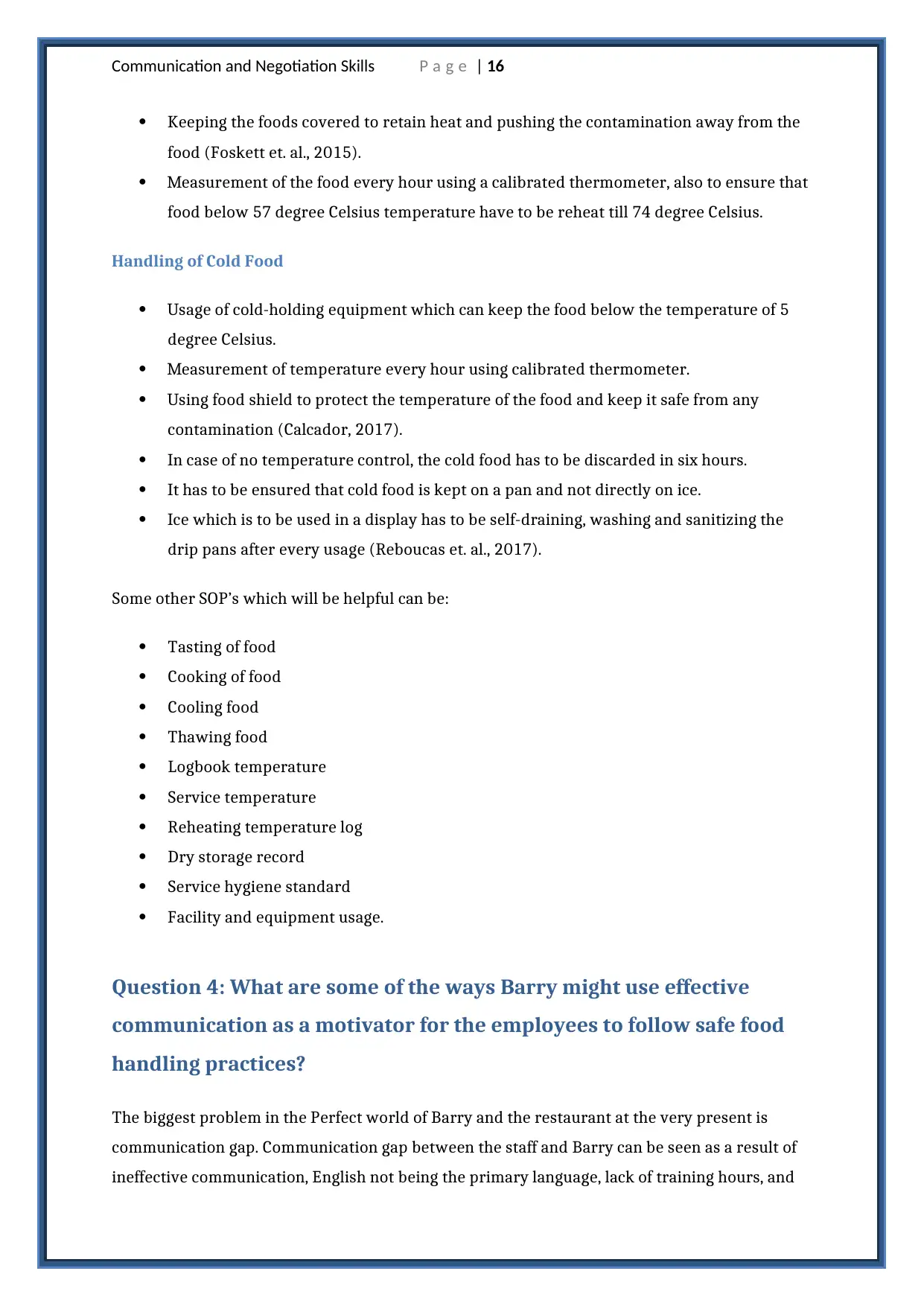
Communication and Negotiation Skills P a g e | 16
Keeping the foods covered to retain heat and pushing the contamination away from the
food (Foskett et. al., 2015).
Measurement of the food every hour using a calibrated thermometer, also to ensure that
food below 57 degree Celsius temperature have to be reheat till 74 degree Celsius.
Handling of Cold Food
Usage of cold-holding equipment which can keep the food below the temperature of 5
degree Celsius.
Measurement of temperature every hour using calibrated thermometer.
Using food shield to protect the temperature of the food and keep it safe from any
contamination (Calcador, 2017).
In case of no temperature control, the cold food has to be discarded in six hours.
It has to be ensured that cold food is kept on a pan and not directly on ice.
Ice which is to be used in a display has to be self-draining, washing and sanitizing the
drip pans after every usage (Reboucas et. al., 2017).
Some other SOP’s which will be helpful can be:
Tasting of food
Cooking of food
Cooling food
Thawing food
Logbook temperature
Service temperature
Reheating temperature log
Dry storage record
Service hygiene standard
Facility and equipment usage.
Question 4: What are some of the ways Barry might use effective
communication as a motivator for the employees to follow safe food
handling practices?
The biggest problem in the Perfect world of Barry and the restaurant at the very present is
communication gap. Communication gap between the staff and Barry can be seen as a result of
ineffective communication, English not being the primary language, lack of training hours, and
Keeping the foods covered to retain heat and pushing the contamination away from the
food (Foskett et. al., 2015).
Measurement of the food every hour using a calibrated thermometer, also to ensure that
food below 57 degree Celsius temperature have to be reheat till 74 degree Celsius.
Handling of Cold Food
Usage of cold-holding equipment which can keep the food below the temperature of 5
degree Celsius.
Measurement of temperature every hour using calibrated thermometer.
Using food shield to protect the temperature of the food and keep it safe from any
contamination (Calcador, 2017).
In case of no temperature control, the cold food has to be discarded in six hours.
It has to be ensured that cold food is kept on a pan and not directly on ice.
Ice which is to be used in a display has to be self-draining, washing and sanitizing the
drip pans after every usage (Reboucas et. al., 2017).
Some other SOP’s which will be helpful can be:
Tasting of food
Cooking of food
Cooling food
Thawing food
Logbook temperature
Service temperature
Reheating temperature log
Dry storage record
Service hygiene standard
Facility and equipment usage.
Question 4: What are some of the ways Barry might use effective
communication as a motivator for the employees to follow safe food
handling practices?
The biggest problem in the Perfect world of Barry and the restaurant at the very present is
communication gap. Communication gap between the staff and Barry can be seen as a result of
ineffective communication, English not being the primary language, lack of training hours, and
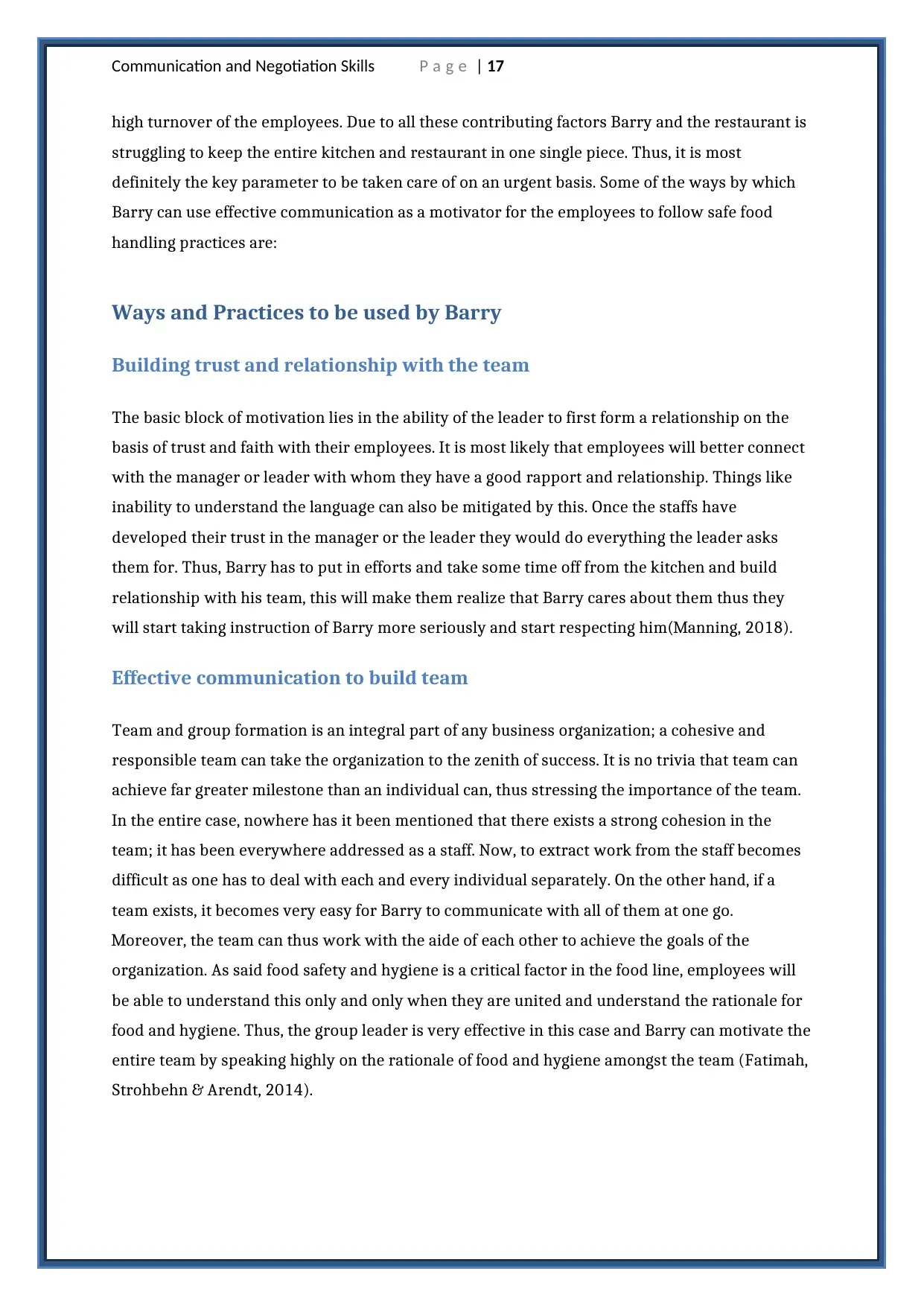
Communication and Negotiation Skills P a g e | 17
high turnover of the employees. Due to all these contributing factors Barry and the restaurant is
struggling to keep the entire kitchen and restaurant in one single piece. Thus, it is most
definitely the key parameter to be taken care of on an urgent basis. Some of the ways by which
Barry can use effective communication as a motivator for the employees to follow safe food
handling practices are:
Ways and Practices to be used by Barry
Building trust and relationship with the team
The basic block of motivation lies in the ability of the leader to first form a relationship on the
basis of trust and faith with their employees. It is most likely that employees will better connect
with the manager or leader with whom they have a good rapport and relationship. Things like
inability to understand the language can also be mitigated by this. Once the staffs have
developed their trust in the manager or the leader they would do everything the leader asks
them for. Thus, Barry has to put in efforts and take some time off from the kitchen and build
relationship with his team, this will make them realize that Barry cares about them thus they
will start taking instruction of Barry more seriously and start respecting him(Manning, 2018).
Effective communication to build team
Team and group formation is an integral part of any business organization; a cohesive and
responsible team can take the organization to the zenith of success. It is no trivia that team can
achieve far greater milestone than an individual can, thus stressing the importance of the team.
In the entire case, nowhere has it been mentioned that there exists a strong cohesion in the
team; it has been everywhere addressed as a staff. Now, to extract work from the staff becomes
difficult as one has to deal with each and every individual separately. On the other hand, if a
team exists, it becomes very easy for Barry to communicate with all of them at one go.
Moreover, the team can thus work with the aide of each other to achieve the goals of the
organization. As said food safety and hygiene is a critical factor in the food line, employees will
be able to understand this only and only when they are united and understand the rationale for
food and hygiene. Thus, the group leader is very effective in this case and Barry can motivate the
entire team by speaking highly on the rationale of food and hygiene amongst the team (Fatimah,
Strohbehn & Arendt, 2014).
high turnover of the employees. Due to all these contributing factors Barry and the restaurant is
struggling to keep the entire kitchen and restaurant in one single piece. Thus, it is most
definitely the key parameter to be taken care of on an urgent basis. Some of the ways by which
Barry can use effective communication as a motivator for the employees to follow safe food
handling practices are:
Ways and Practices to be used by Barry
Building trust and relationship with the team
The basic block of motivation lies in the ability of the leader to first form a relationship on the
basis of trust and faith with their employees. It is most likely that employees will better connect
with the manager or leader with whom they have a good rapport and relationship. Things like
inability to understand the language can also be mitigated by this. Once the staffs have
developed their trust in the manager or the leader they would do everything the leader asks
them for. Thus, Barry has to put in efforts and take some time off from the kitchen and build
relationship with his team, this will make them realize that Barry cares about them thus they
will start taking instruction of Barry more seriously and start respecting him(Manning, 2018).
Effective communication to build team
Team and group formation is an integral part of any business organization; a cohesive and
responsible team can take the organization to the zenith of success. It is no trivia that team can
achieve far greater milestone than an individual can, thus stressing the importance of the team.
In the entire case, nowhere has it been mentioned that there exists a strong cohesion in the
team; it has been everywhere addressed as a staff. Now, to extract work from the staff becomes
difficult as one has to deal with each and every individual separately. On the other hand, if a
team exists, it becomes very easy for Barry to communicate with all of them at one go.
Moreover, the team can thus work with the aide of each other to achieve the goals of the
organization. As said food safety and hygiene is a critical factor in the food line, employees will
be able to understand this only and only when they are united and understand the rationale for
food and hygiene. Thus, the group leader is very effective in this case and Barry can motivate the
entire team by speaking highly on the rationale of food and hygiene amongst the team (Fatimah,
Strohbehn & Arendt, 2014).
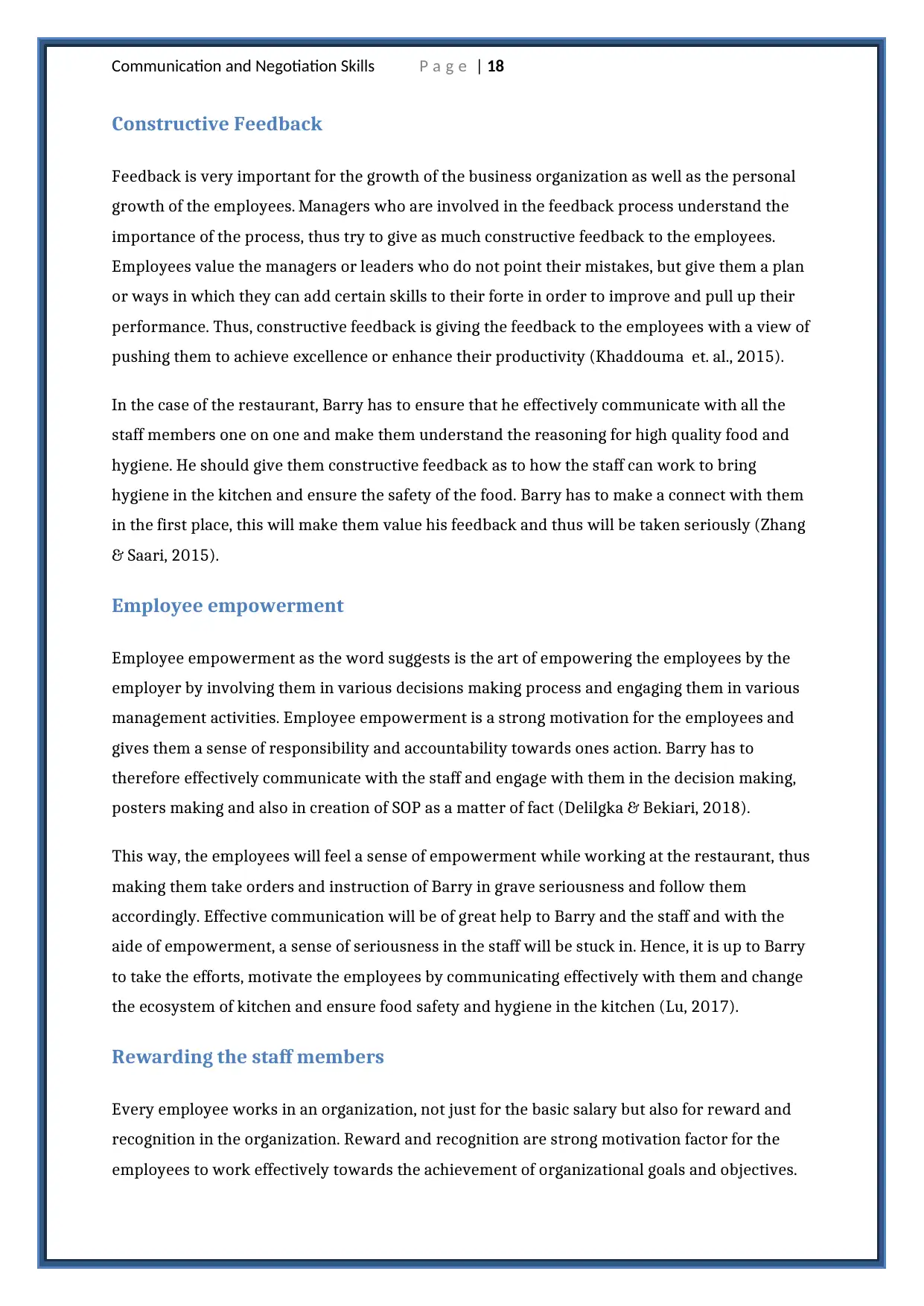
Communication and Negotiation Skills P a g e | 18
Constructive Feedback
Feedback is very important for the growth of the business organization as well as the personal
growth of the employees. Managers who are involved in the feedback process understand the
importance of the process, thus try to give as much constructive feedback to the employees.
Employees value the managers or leaders who do not point their mistakes, but give them a plan
or ways in which they can add certain skills to their forte in order to improve and pull up their
performance. Thus, constructive feedback is giving the feedback to the employees with a view of
pushing them to achieve excellence or enhance their productivity (Khaddouma et. al., 2015).
In the case of the restaurant, Barry has to ensure that he effectively communicate with all the
staff members one on one and make them understand the reasoning for high quality food and
hygiene. He should give them constructive feedback as to how the staff can work to bring
hygiene in the kitchen and ensure the safety of the food. Barry has to make a connect with them
in the first place, this will make them value his feedback and thus will be taken seriously (Zhang
& Saari, 2015).
Employee empowerment
Employee empowerment as the word suggests is the art of empowering the employees by the
employer by involving them in various decisions making process and engaging them in various
management activities. Employee empowerment is a strong motivation for the employees and
gives them a sense of responsibility and accountability towards ones action. Barry has to
therefore effectively communicate with the staff and engage with them in the decision making,
posters making and also in creation of SOP as a matter of fact (Delilgka & Bekiari, 2018).
This way, the employees will feel a sense of empowerment while working at the restaurant, thus
making them take orders and instruction of Barry in grave seriousness and follow them
accordingly. Effective communication will be of great help to Barry and the staff and with the
aide of empowerment, a sense of seriousness in the staff will be stuck in. Hence, it is up to Barry
to take the efforts, motivate the employees by communicating effectively with them and change
the ecosystem of kitchen and ensure food safety and hygiene in the kitchen (Lu, 2017).
Rewarding the staff members
Every employee works in an organization, not just for the basic salary but also for reward and
recognition in the organization. Reward and recognition are strong motivation factor for the
employees to work effectively towards the achievement of organizational goals and objectives.
Constructive Feedback
Feedback is very important for the growth of the business organization as well as the personal
growth of the employees. Managers who are involved in the feedback process understand the
importance of the process, thus try to give as much constructive feedback to the employees.
Employees value the managers or leaders who do not point their mistakes, but give them a plan
or ways in which they can add certain skills to their forte in order to improve and pull up their
performance. Thus, constructive feedback is giving the feedback to the employees with a view of
pushing them to achieve excellence or enhance their productivity (Khaddouma et. al., 2015).
In the case of the restaurant, Barry has to ensure that he effectively communicate with all the
staff members one on one and make them understand the reasoning for high quality food and
hygiene. He should give them constructive feedback as to how the staff can work to bring
hygiene in the kitchen and ensure the safety of the food. Barry has to make a connect with them
in the first place, this will make them value his feedback and thus will be taken seriously (Zhang
& Saari, 2015).
Employee empowerment
Employee empowerment as the word suggests is the art of empowering the employees by the
employer by involving them in various decisions making process and engaging them in various
management activities. Employee empowerment is a strong motivation for the employees and
gives them a sense of responsibility and accountability towards ones action. Barry has to
therefore effectively communicate with the staff and engage with them in the decision making,
posters making and also in creation of SOP as a matter of fact (Delilgka & Bekiari, 2018).
This way, the employees will feel a sense of empowerment while working at the restaurant, thus
making them take orders and instruction of Barry in grave seriousness and follow them
accordingly. Effective communication will be of great help to Barry and the staff and with the
aide of empowerment, a sense of seriousness in the staff will be stuck in. Hence, it is up to Barry
to take the efforts, motivate the employees by communicating effectively with them and change
the ecosystem of kitchen and ensure food safety and hygiene in the kitchen (Lu, 2017).
Rewarding the staff members
Every employee works in an organization, not just for the basic salary but also for reward and
recognition in the organization. Reward and recognition are strong motivation factor for the
employees to work effectively towards the achievement of organizational goals and objectives.
Paraphrase This Document
Need a fresh take? Get an instant paraphrase of this document with our AI Paraphraser

Communication and Negotiation Skills P a g e | 19
The employees have to know that their efforts are being valued and someone is always keeping
an eye on them evaluating their performance, they will definitely do a great job. Plethora of
motivation theories in the past and present give high weightage to reward and recognition as a
source of motivation for the employees (Datt & Ram, 2014).
Barry has to ensure that he effectively communicates the policy of reward and recognition for
number of critical elements in kitchen, such as the person with best grooming, person with best
cleaning skills and many more. These small awards will push the staff members to perform at
their optimum best thus ensuring following of the procedures and policies of the kitchen.
Growth, Learning and Development
It is often seen that many of the employees are not motivated by money or any reward, they get
motivated and stick in the organization if they are being provided with consistent learning,
growth and development in the organization. Employees value organization which is working
towards the professional development of its employees. This is seen as a reflection of the
training provided to the employees, pushing the employees to pick up a new skill set or give
them an opportunity to explore other opportunities. Barry in this case has to make sure he
effectively communicates with the staff members, make them understand that he values them,
and ensure that numerous training exercises will be conducted which will give an impetus to
their professional productivity. This way, the employees will get motivated; push them to obey
the instruction, orders and command of Barry and work with him to achieve hygiene, food
safety and cleanliness in the Kitchen (Berson et. al., 2015).
The employees have to know that their efforts are being valued and someone is always keeping
an eye on them evaluating their performance, they will definitely do a great job. Plethora of
motivation theories in the past and present give high weightage to reward and recognition as a
source of motivation for the employees (Datt & Ram, 2014).
Barry has to ensure that he effectively communicates the policy of reward and recognition for
number of critical elements in kitchen, such as the person with best grooming, person with best
cleaning skills and many more. These small awards will push the staff members to perform at
their optimum best thus ensuring following of the procedures and policies of the kitchen.
Growth, Learning and Development
It is often seen that many of the employees are not motivated by money or any reward, they get
motivated and stick in the organization if they are being provided with consistent learning,
growth and development in the organization. Employees value organization which is working
towards the professional development of its employees. This is seen as a reflection of the
training provided to the employees, pushing the employees to pick up a new skill set or give
them an opportunity to explore other opportunities. Barry in this case has to make sure he
effectively communicates with the staff members, make them understand that he values them,
and ensure that numerous training exercises will be conducted which will give an impetus to
their professional productivity. This way, the employees will get motivated; push them to obey
the instruction, orders and command of Barry and work with him to achieve hygiene, food
safety and cleanliness in the Kitchen (Berson et. al., 2015).
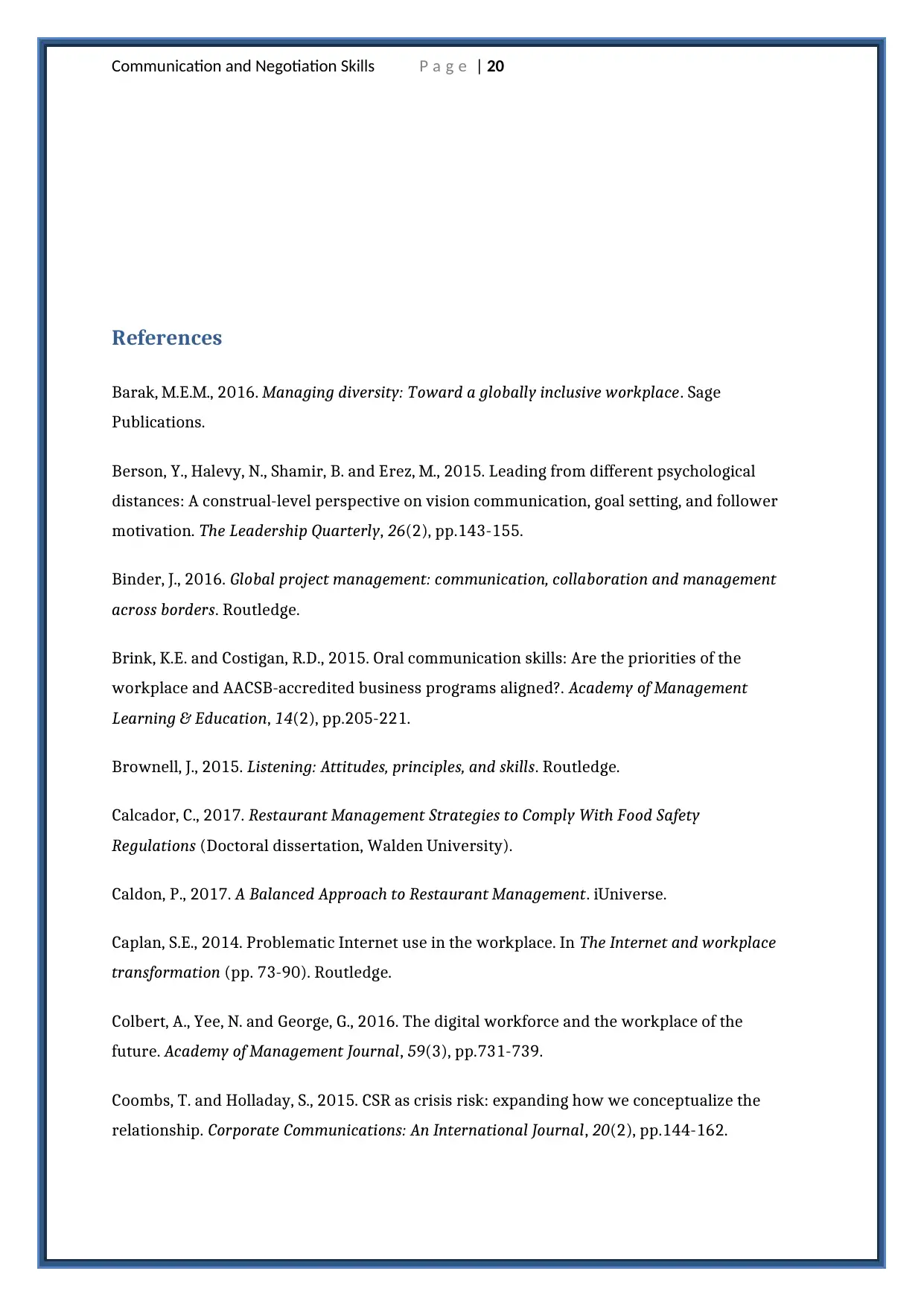
Communication and Negotiation Skills P a g e | 20
References
Barak, M.E.M., 2016. Managing diversity: Toward a globally inclusive workplace. Sage
Publications.
Berson, Y., Halevy, N., Shamir, B. and Erez, M., 2015. Leading from different psychological
distances: A construal-level perspective on vision communication, goal setting, and follower
motivation. The Leadership Quarterly, 26(2), pp.143-155.
Binder, J., 2016. Global project management: communication, collaboration and management
across borders. Routledge.
Brink, K.E. and Costigan, R.D., 2015. Oral communication skills: Are the priorities of the
workplace and AACSB-accredited business programs aligned?. Academy of Management
Learning & Education, 14(2), pp.205-221.
Brownell, J., 2015. Listening: Attitudes, principles, and skills. Routledge.
Calcador, C., 2017. Restaurant Management Strategies to Comply With Food Safety
Regulations (Doctoral dissertation, Walden University).
Caldon, P., 2017. A Balanced Approach to Restaurant Management. iUniverse.
Caplan, S.E., 2014. Problematic Internet use in the workplace. In The Internet and workplace
transformation (pp. 73-90). Routledge.
Colbert, A., Yee, N. and George, G., 2016. The digital workforce and the workplace of the
future. Academy of Management Journal, 59(3), pp.731-739.
Coombs, T. and Holladay, S., 2015. CSR as crisis risk: expanding how we conceptualize the
relationship. Corporate Communications: An International Journal, 20(2), pp.144-162.
References
Barak, M.E.M., 2016. Managing diversity: Toward a globally inclusive workplace. Sage
Publications.
Berson, Y., Halevy, N., Shamir, B. and Erez, M., 2015. Leading from different psychological
distances: A construal-level perspective on vision communication, goal setting, and follower
motivation. The Leadership Quarterly, 26(2), pp.143-155.
Binder, J., 2016. Global project management: communication, collaboration and management
across borders. Routledge.
Brink, K.E. and Costigan, R.D., 2015. Oral communication skills: Are the priorities of the
workplace and AACSB-accredited business programs aligned?. Academy of Management
Learning & Education, 14(2), pp.205-221.
Brownell, J., 2015. Listening: Attitudes, principles, and skills. Routledge.
Calcador, C., 2017. Restaurant Management Strategies to Comply With Food Safety
Regulations (Doctoral dissertation, Walden University).
Caldon, P., 2017. A Balanced Approach to Restaurant Management. iUniverse.
Caplan, S.E., 2014. Problematic Internet use in the workplace. In The Internet and workplace
transformation (pp. 73-90). Routledge.
Colbert, A., Yee, N. and George, G., 2016. The digital workforce and the workplace of the
future. Academy of Management Journal, 59(3), pp.731-739.
Coombs, T. and Holladay, S., 2015. CSR as crisis risk: expanding how we conceptualize the
relationship. Corporate Communications: An International Journal, 20(2), pp.144-162.
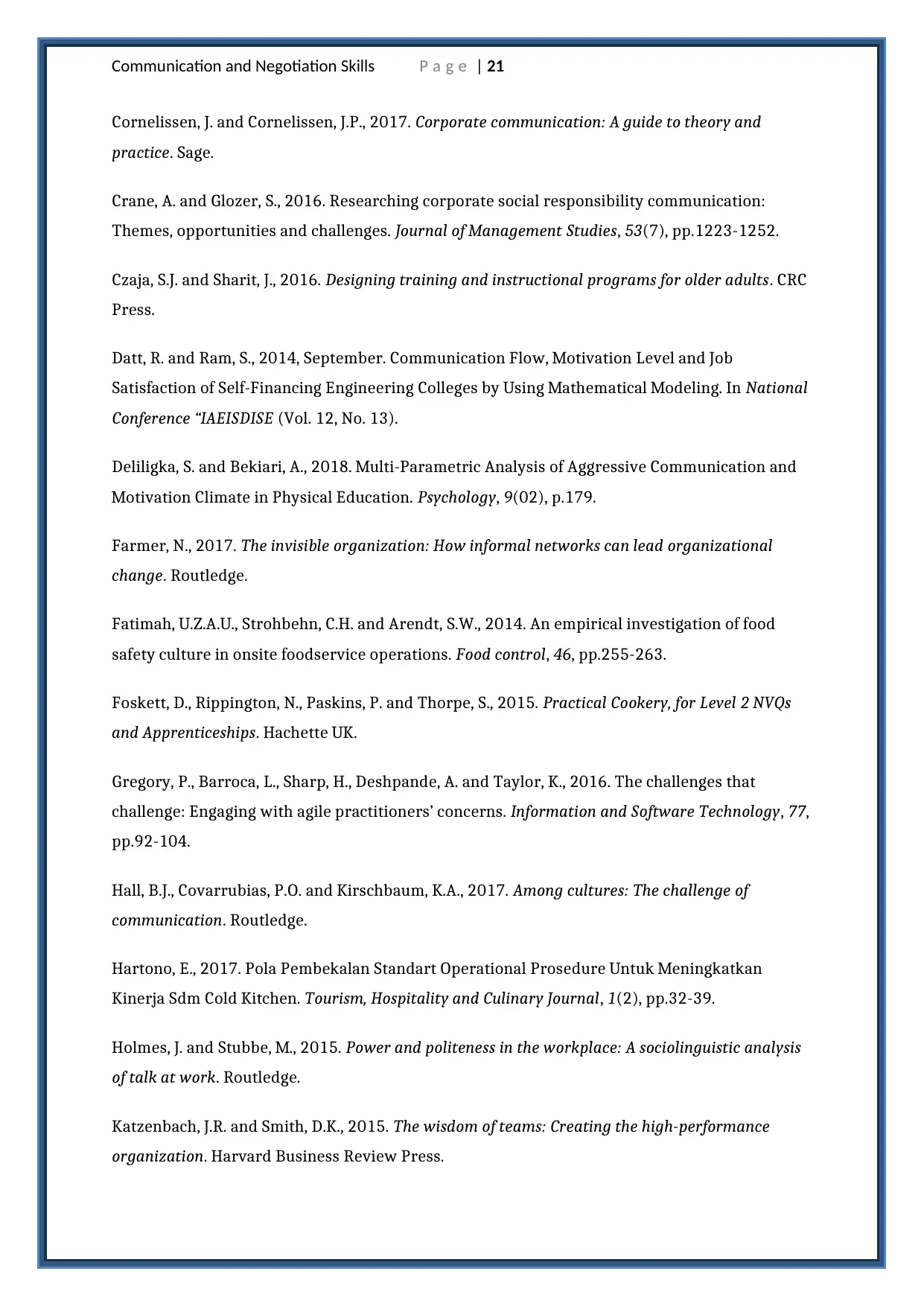
Communication and Negotiation Skills P a g e | 21
Cornelissen, J. and Cornelissen, J.P., 2017. Corporate communication: A guide to theory and
practice. Sage.
Crane, A. and Glozer, S., 2016. Researching corporate social responsibility communication:
Themes, opportunities and challenges. Journal of Management Studies, 53(7), pp.1223-1252.
Czaja, S.J. and Sharit, J., 2016. Designing training and instructional programs for older adults. CRC
Press.
Datt, R. and Ram, S., 2014, September. Communication Flow, Motivation Level and Job
Satisfaction of Self-Financing Engineering Colleges by Using Mathematical Modeling. In National
Conference “IAEISDISE (Vol. 12, No. 13).
Deliligka, S. and Bekiari, A., 2018. Multi-Parametric Analysis of Aggressive Communication and
Motivation Climate in Physical Education. Psychology, 9(02), p.179.
Farmer, N., 2017. The invisible organization: How informal networks can lead organizational
change. Routledge.
Fatimah, U.Z.A.U., Strohbehn, C.H. and Arendt, S.W., 2014. An empirical investigation of food
safety culture in onsite foodservice operations. Food control, 46, pp.255-263.
Foskett, D., Rippington, N., Paskins, P. and Thorpe, S., 2015. Practical Cookery, for Level 2 NVQs
and Apprenticeships. Hachette UK.
Gregory, P., Barroca, L., Sharp, H., Deshpande, A. and Taylor, K., 2016. The challenges that
challenge: Engaging with agile practitioners’ concerns. Information and Software Technology, 77,
pp.92-104.
Hall, B.J., Covarrubias, P.O. and Kirschbaum, K.A., 2017. Among cultures: The challenge of
communication. Routledge.
Hartono, E., 2017. Pola Pembekalan Standart Operational Prosedure Untuk Meningkatkan
Kinerja Sdm Cold Kitchen. Tourism, Hospitality and Culinary Journal, 1(2), pp.32-39.
Holmes, J. and Stubbe, M., 2015. Power and politeness in the workplace: A sociolinguistic analysis
of talk at work. Routledge.
Katzenbach, J.R. and Smith, D.K., 2015. The wisdom of teams: Creating the high-performance
organization. Harvard Business Review Press.
Cornelissen, J. and Cornelissen, J.P., 2017. Corporate communication: A guide to theory and
practice. Sage.
Crane, A. and Glozer, S., 2016. Researching corporate social responsibility communication:
Themes, opportunities and challenges. Journal of Management Studies, 53(7), pp.1223-1252.
Czaja, S.J. and Sharit, J., 2016. Designing training and instructional programs for older adults. CRC
Press.
Datt, R. and Ram, S., 2014, September. Communication Flow, Motivation Level and Job
Satisfaction of Self-Financing Engineering Colleges by Using Mathematical Modeling. In National
Conference “IAEISDISE (Vol. 12, No. 13).
Deliligka, S. and Bekiari, A., 2018. Multi-Parametric Analysis of Aggressive Communication and
Motivation Climate in Physical Education. Psychology, 9(02), p.179.
Farmer, N., 2017. The invisible organization: How informal networks can lead organizational
change. Routledge.
Fatimah, U.Z.A.U., Strohbehn, C.H. and Arendt, S.W., 2014. An empirical investigation of food
safety culture in onsite foodservice operations. Food control, 46, pp.255-263.
Foskett, D., Rippington, N., Paskins, P. and Thorpe, S., 2015. Practical Cookery, for Level 2 NVQs
and Apprenticeships. Hachette UK.
Gregory, P., Barroca, L., Sharp, H., Deshpande, A. and Taylor, K., 2016. The challenges that
challenge: Engaging with agile practitioners’ concerns. Information and Software Technology, 77,
pp.92-104.
Hall, B.J., Covarrubias, P.O. and Kirschbaum, K.A., 2017. Among cultures: The challenge of
communication. Routledge.
Hartono, E., 2017. Pola Pembekalan Standart Operational Prosedure Untuk Meningkatkan
Kinerja Sdm Cold Kitchen. Tourism, Hospitality and Culinary Journal, 1(2), pp.32-39.
Holmes, J. and Stubbe, M., 2015. Power and politeness in the workplace: A sociolinguistic analysis
of talk at work. Routledge.
Katzenbach, J.R. and Smith, D.K., 2015. The wisdom of teams: Creating the high-performance
organization. Harvard Business Review Press.
Secure Best Marks with AI Grader
Need help grading? Try our AI Grader for instant feedback on your assignments.
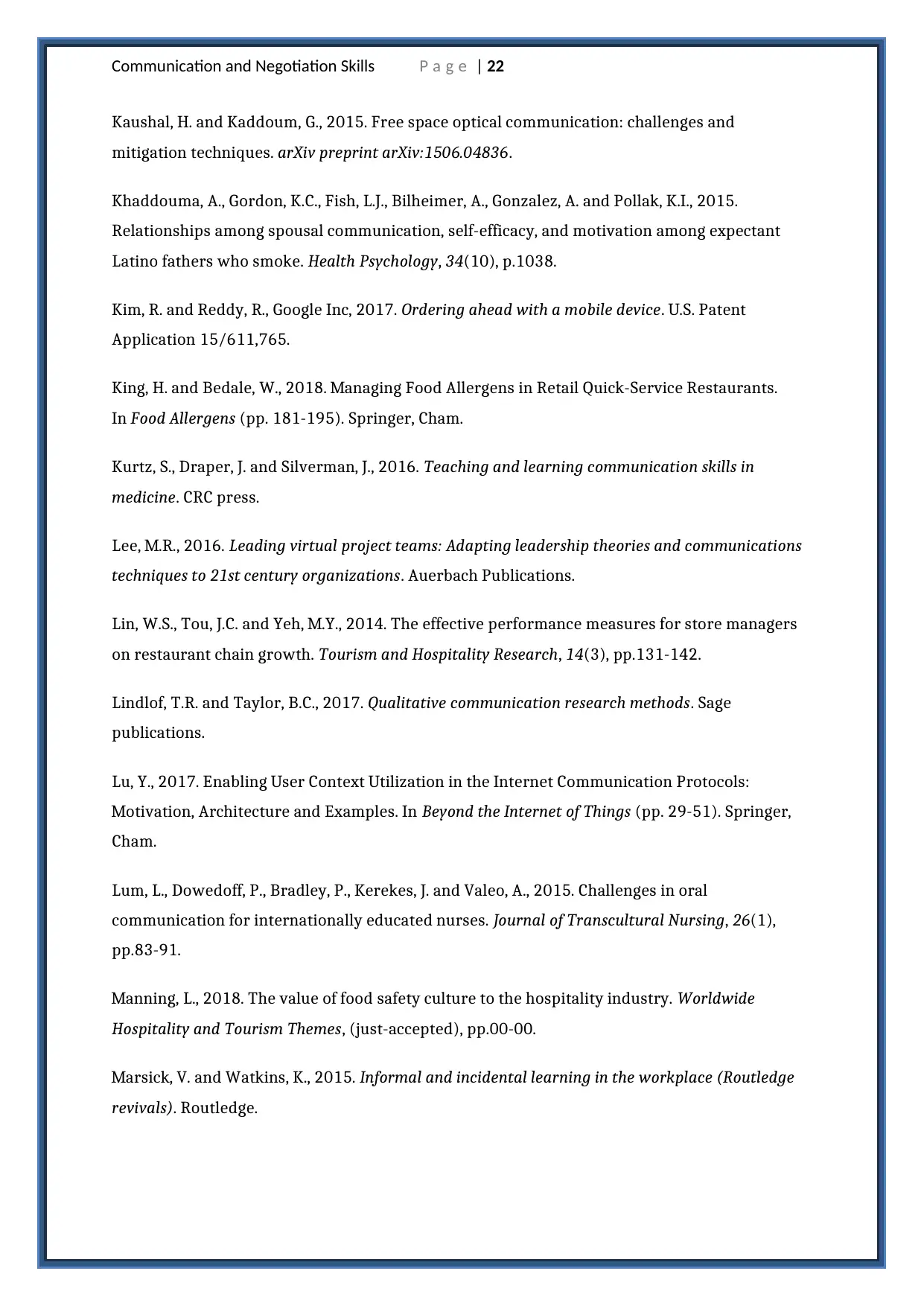
Communication and Negotiation Skills P a g e | 22
Kaushal, H. and Kaddoum, G., 2015. Free space optical communication: challenges and
mitigation techniques. arXiv preprint arXiv:1506.04836.
Khaddouma, A., Gordon, K.C., Fish, L.J., Bilheimer, A., Gonzalez, A. and Pollak, K.I., 2015.
Relationships among spousal communication, self-efficacy, and motivation among expectant
Latino fathers who smoke. Health Psychology, 34(10), p.1038.
Kim, R. and Reddy, R., Google Inc, 2017. Ordering ahead with a mobile device. U.S. Patent
Application 15/611,765.
King, H. and Bedale, W., 2018. Managing Food Allergens in Retail Quick-Service Restaurants.
In Food Allergens (pp. 181-195). Springer, Cham.
Kurtz, S., Draper, J. and Silverman, J., 2016. Teaching and learning communication skills in
medicine. CRC press.
Lee, M.R., 2016. Leading virtual project teams: Adapting leadership theories and communications
techniques to 21st century organizations. Auerbach Publications.
Lin, W.S., Tou, J.C. and Yeh, M.Y., 2014. The effective performance measures for store managers
on restaurant chain growth. Tourism and Hospitality Research, 14(3), pp.131-142.
Lindlof, T.R. and Taylor, B.C., 2017. Qualitative communication research methods. Sage
publications.
Lu, Y., 2017. Enabling User Context Utilization in the Internet Communication Protocols:
Motivation, Architecture and Examples. In Beyond the Internet of Things (pp. 29-51). Springer,
Cham.
Lum, L., Dowedoff, P., Bradley, P., Kerekes, J. and Valeo, A., 2015. Challenges in oral
communication for internationally educated nurses. Journal of Transcultural Nursing, 26(1),
pp.83-91.
Manning, L., 2018. The value of food safety culture to the hospitality industry. Worldwide
Hospitality and Tourism Themes, (just-accepted), pp.00-00.
Marsick, V. and Watkins, K., 2015. Informal and incidental learning in the workplace (Routledge
revivals). Routledge.
Kaushal, H. and Kaddoum, G., 2015. Free space optical communication: challenges and
mitigation techniques. arXiv preprint arXiv:1506.04836.
Khaddouma, A., Gordon, K.C., Fish, L.J., Bilheimer, A., Gonzalez, A. and Pollak, K.I., 2015.
Relationships among spousal communication, self-efficacy, and motivation among expectant
Latino fathers who smoke. Health Psychology, 34(10), p.1038.
Kim, R. and Reddy, R., Google Inc, 2017. Ordering ahead with a mobile device. U.S. Patent
Application 15/611,765.
King, H. and Bedale, W., 2018. Managing Food Allergens in Retail Quick-Service Restaurants.
In Food Allergens (pp. 181-195). Springer, Cham.
Kurtz, S., Draper, J. and Silverman, J., 2016. Teaching and learning communication skills in
medicine. CRC press.
Lee, M.R., 2016. Leading virtual project teams: Adapting leadership theories and communications
techniques to 21st century organizations. Auerbach Publications.
Lin, W.S., Tou, J.C. and Yeh, M.Y., 2014. The effective performance measures for store managers
on restaurant chain growth. Tourism and Hospitality Research, 14(3), pp.131-142.
Lindlof, T.R. and Taylor, B.C., 2017. Qualitative communication research methods. Sage
publications.
Lu, Y., 2017. Enabling User Context Utilization in the Internet Communication Protocols:
Motivation, Architecture and Examples. In Beyond the Internet of Things (pp. 29-51). Springer,
Cham.
Lum, L., Dowedoff, P., Bradley, P., Kerekes, J. and Valeo, A., 2015. Challenges in oral
communication for internationally educated nurses. Journal of Transcultural Nursing, 26(1),
pp.83-91.
Manning, L., 2018. The value of food safety culture to the hospitality industry. Worldwide
Hospitality and Tourism Themes, (just-accepted), pp.00-00.
Marsick, V. and Watkins, K., 2015. Informal and incidental learning in the workplace (Routledge
revivals). Routledge.

Communication and Negotiation Skills P a g e | 23
Martin, J.N. and Nakayama, T.K., 2015. Reconsidering intercultural (communication)
competence in the workplace: A dialectical approach. Language and Intercultural
Communication, 15(1), pp.13-28.
Moser, S.C., 2016. Reflections on climate change communication research and practice in the
second decade of the 21st century: what more is there to say?. Wiley Interdisciplinary Reviews:
Climate Change, 7(3), pp.345-369.
O’Donnell, S.M. and MacIntosh, J.A., 2016. Gender and workplace bullying: men’s experiences of
surviving bullying at work. Qualitative health research, 26(3), pp.351-366.
Olmedo, E., 2015. The Hotel as Workplace: Technology Transfer and Identity Formation.
In Identity at Work (pp. 127-175). Springer, Singapore.
O'Toole, G., 2016. Communication-eBook: Core Interpersonal Skills for Health Professionals.
Elsevier Health Sciences.
Pramadhika, R., 2017. An Analysis of Front Office in Supporting the Guests Satisfaction during
staying in California Hotel Bandung. Rezkyanto Pramadhika: 127010008(Doctoral dissertation,
Sastra Inggris).
Rebouças, L.T., Santiago, L.B., Martins, L.S., Menezes, A.C.R., Araújo, M.D.P.N. and de Castro
Almeida, R.C., 2017. Food safety knowledge and practices of food handlers, head chefs and
managers in hotels' restaurants of Salvador, Brazil. Food Control, 73, pp.372-381.
Samovar, L.A., Porter, R.E., McDaniel, E.R. and Roy, C.S., 2015. Communication between cultures.
Nelson Education.
Schwartz, A., 2018. Cooking in a Small Kitchen. Picador.
Serrat, O., 2017. Harnessing creativity and innovation in the workplace. In Knowledge
Solutions (pp. 903-910). Springer, Singapore.
Ulmer, R.R., Sellnow, T.L. and Seeger, M.W., 2017. Effective crisis communication: Moving from
crisis to opportunity. Sage Publications.
Vega, D., 2016. Present and future restaurant management competencies: an industry
perspective (Doctoral dissertation, Kansas State University).
Martin, J.N. and Nakayama, T.K., 2015. Reconsidering intercultural (communication)
competence in the workplace: A dialectical approach. Language and Intercultural
Communication, 15(1), pp.13-28.
Moser, S.C., 2016. Reflections on climate change communication research and practice in the
second decade of the 21st century: what more is there to say?. Wiley Interdisciplinary Reviews:
Climate Change, 7(3), pp.345-369.
O’Donnell, S.M. and MacIntosh, J.A., 2016. Gender and workplace bullying: men’s experiences of
surviving bullying at work. Qualitative health research, 26(3), pp.351-366.
Olmedo, E., 2015. The Hotel as Workplace: Technology Transfer and Identity Formation.
In Identity at Work (pp. 127-175). Springer, Singapore.
O'Toole, G., 2016. Communication-eBook: Core Interpersonal Skills for Health Professionals.
Elsevier Health Sciences.
Pramadhika, R., 2017. An Analysis of Front Office in Supporting the Guests Satisfaction during
staying in California Hotel Bandung. Rezkyanto Pramadhika: 127010008(Doctoral dissertation,
Sastra Inggris).
Rebouças, L.T., Santiago, L.B., Martins, L.S., Menezes, A.C.R., Araújo, M.D.P.N. and de Castro
Almeida, R.C., 2017. Food safety knowledge and practices of food handlers, head chefs and
managers in hotels' restaurants of Salvador, Brazil. Food Control, 73, pp.372-381.
Samovar, L.A., Porter, R.E., McDaniel, E.R. and Roy, C.S., 2015. Communication between cultures.
Nelson Education.
Schwartz, A., 2018. Cooking in a Small Kitchen. Picador.
Serrat, O., 2017. Harnessing creativity and innovation in the workplace. In Knowledge
Solutions (pp. 903-910). Springer, Singapore.
Ulmer, R.R., Sellnow, T.L. and Seeger, M.W., 2017. Effective crisis communication: Moving from
crisis to opportunity. Sage Publications.
Vega, D., 2016. Present and future restaurant management competencies: an industry
perspective (Doctoral dissertation, Kansas State University).
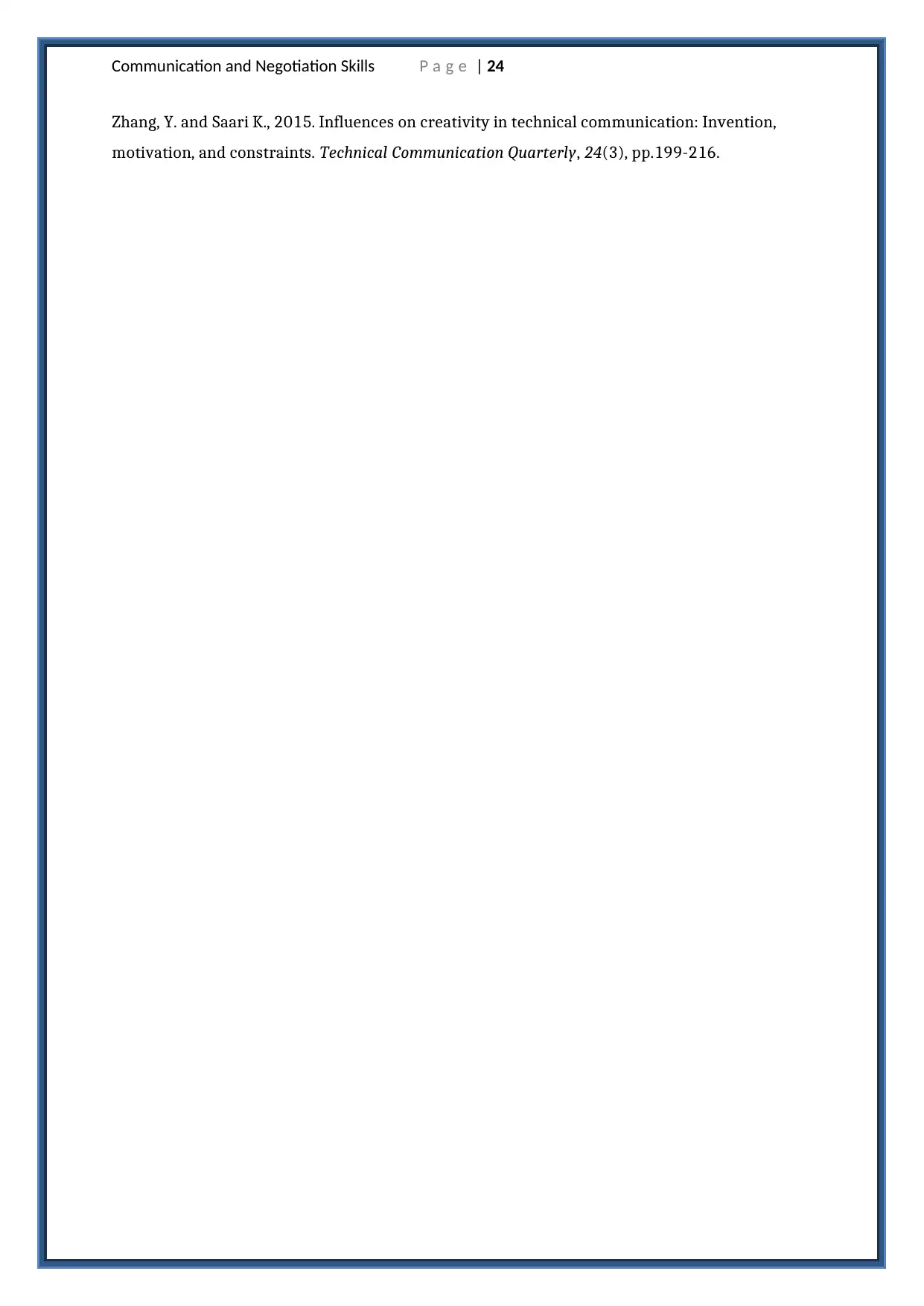
Communication and Negotiation Skills P a g e | 24
Zhang, Y. and Saari K., 2015. Influences on creativity in technical communication: Invention,
motivation, and constraints. Technical Communication Quarterly, 24(3), pp.199-216.
Zhang, Y. and Saari K., 2015. Influences on creativity in technical communication: Invention,
motivation, and constraints. Technical Communication Quarterly, 24(3), pp.199-216.
1 out of 25
Related Documents
Your All-in-One AI-Powered Toolkit for Academic Success.
+13062052269
info@desklib.com
Available 24*7 on WhatsApp / Email
![[object Object]](/_next/static/media/star-bottom.7253800d.svg)
Unlock your academic potential
© 2024 | Zucol Services PVT LTD | All rights reserved.




